Consumption of Meat over the World - PDF
VerifiedAdded on 2021/06/16
|22
|4688
|14
AI Summary
Contribute Materials
Your contribution can guide someone’s learning journey. Share your
documents today.
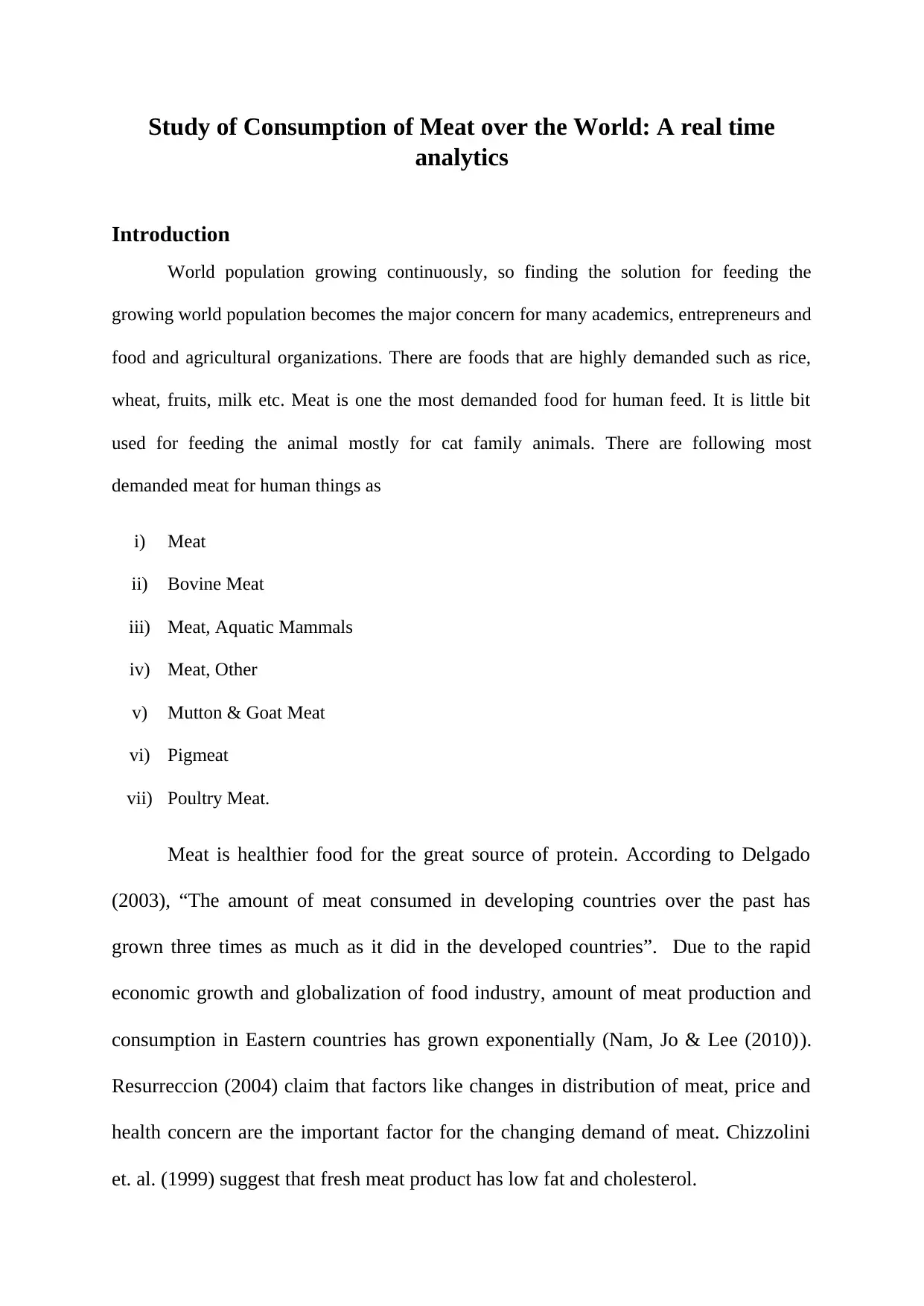
Study of Consumption of Meat over the World: A real time
analytics
Introduction
World population growing continuously, so finding the solution for feeding the
growing world population becomes the major concern for many academics, entrepreneurs and
food and agricultural organizations. There are foods that are highly demanded such as rice,
wheat, fruits, milk etc. Meat is one the most demanded food for human feed. It is little bit
used for feeding the animal mostly for cat family animals. There are following most
demanded meat for human things as
i) Meat
ii) Bovine Meat
iii) Meat, Aquatic Mammals
iv) Meat, Other
v) Mutton & Goat Meat
vi) Pigmeat
vii) Poultry Meat.
Meat is healthier food for the great source of protein. According to Delgado
(2003), “The amount of meat consumed in developing countries over the past has
grown three times as much as it did in the developed countries”. Due to the rapid
economic growth and globalization of food industry, amount of meat production and
consumption in Eastern countries has grown exponentially (Nam, Jo & Lee (2010)).
Resurreccion (2004) claim that factors like changes in distribution of meat, price and
health concern are the important factor for the changing demand of meat. Chizzolini
et. al. (1999) suggest that fresh meat product has low fat and cholesterol.
analytics
Introduction
World population growing continuously, so finding the solution for feeding the
growing world population becomes the major concern for many academics, entrepreneurs and
food and agricultural organizations. There are foods that are highly demanded such as rice,
wheat, fruits, milk etc. Meat is one the most demanded food for human feed. It is little bit
used for feeding the animal mostly for cat family animals. There are following most
demanded meat for human things as
i) Meat
ii) Bovine Meat
iii) Meat, Aquatic Mammals
iv) Meat, Other
v) Mutton & Goat Meat
vi) Pigmeat
vii) Poultry Meat.
Meat is healthier food for the great source of protein. According to Delgado
(2003), “The amount of meat consumed in developing countries over the past has
grown three times as much as it did in the developed countries”. Due to the rapid
economic growth and globalization of food industry, amount of meat production and
consumption in Eastern countries has grown exponentially (Nam, Jo & Lee (2010)).
Resurreccion (2004) claim that factors like changes in distribution of meat, price and
health concern are the important factor for the changing demand of meat. Chizzolini
et. al. (1999) suggest that fresh meat product has low fat and cholesterol.
Secure Best Marks with AI Grader
Need help grading? Try our AI Grader for instant feedback on your assignments.
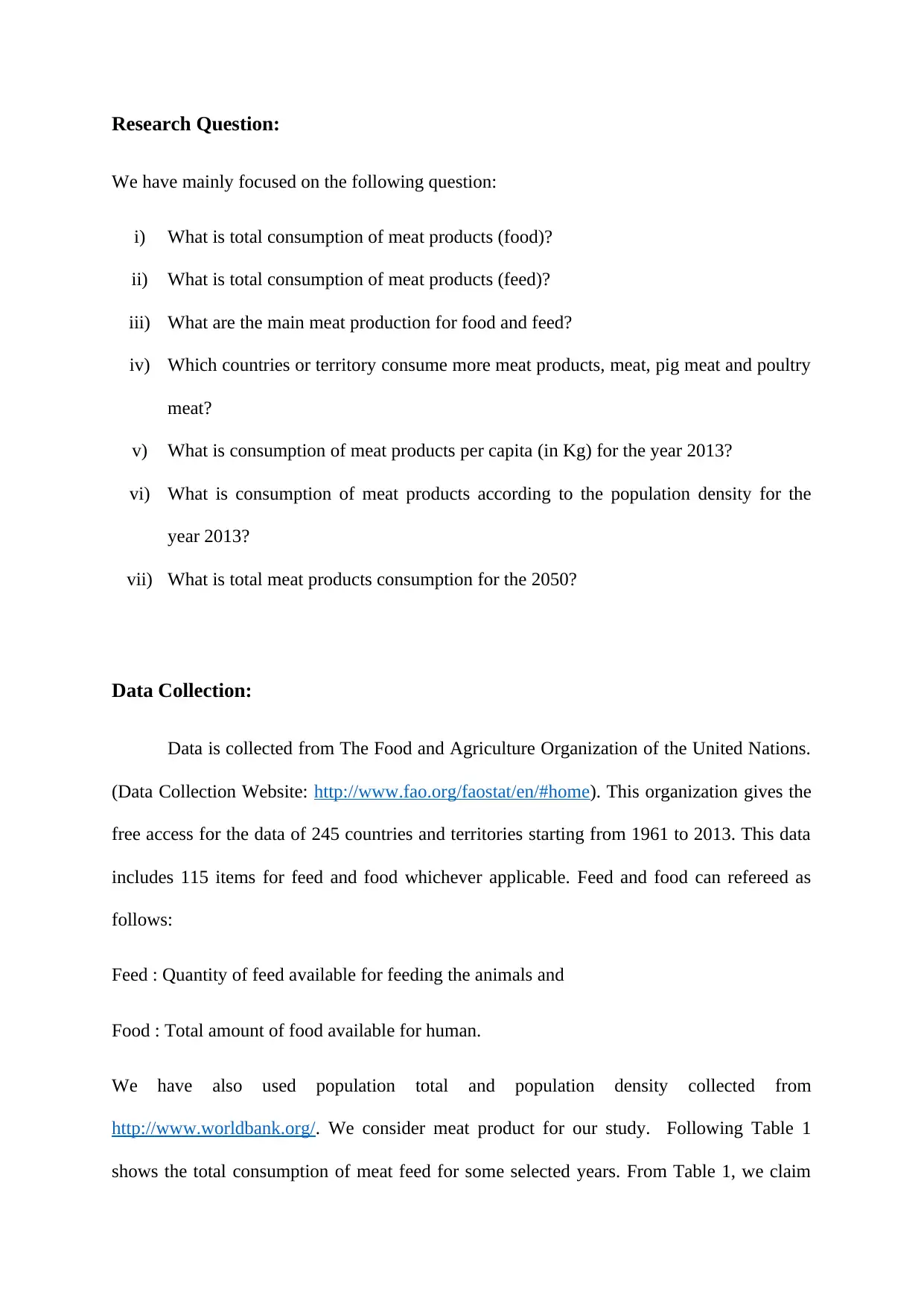
Research Question:
We have mainly focused on the following question:
i) What is total consumption of meat products (food)?
ii) What is total consumption of meat products (feed)?
iii) What are the main meat production for food and feed?
iv) Which countries or territory consume more meat products, meat, pig meat and poultry
meat?
v) What is consumption of meat products per capita (in Kg) for the year 2013?
vi) What is consumption of meat products according to the population density for the
year 2013?
vii) What is total meat products consumption for the 2050?
Data Collection:
Data is collected from The Food and Agriculture Organization of the United Nations.
(Data Collection Website: http://www.fao.org/faostat/en/#home). This organization gives the
free access for the data of 245 countries and territories starting from 1961 to 2013. This data
includes 115 items for feed and food whichever applicable. Feed and food can refereed as
follows:
Feed : Quantity of feed available for feeding the animals and
Food : Total amount of food available for human.
We have also used population total and population density collected from
http://www.worldbank.org/. We consider meat product for our study. Following Table 1
shows the total consumption of meat feed for some selected years. From Table 1, we claim
We have mainly focused on the following question:
i) What is total consumption of meat products (food)?
ii) What is total consumption of meat products (feed)?
iii) What are the main meat production for food and feed?
iv) Which countries or territory consume more meat products, meat, pig meat and poultry
meat?
v) What is consumption of meat products per capita (in Kg) for the year 2013?
vi) What is consumption of meat products according to the population density for the
year 2013?
vii) What is total meat products consumption for the 2050?
Data Collection:
Data is collected from The Food and Agriculture Organization of the United Nations.
(Data Collection Website: http://www.fao.org/faostat/en/#home). This organization gives the
free access for the data of 245 countries and territories starting from 1961 to 2013. This data
includes 115 items for feed and food whichever applicable. Feed and food can refereed as
follows:
Feed : Quantity of feed available for feeding the animals and
Food : Total amount of food available for human.
We have also used population total and population density collected from
http://www.worldbank.org/. We consider meat product for our study. Following Table 1
shows the total consumption of meat feed for some selected years. From Table 1, we claim

say that meat and meat other are the important item in the meat product for feeding the
animal. There is 133% increase in the consumption of meat (feed) from 1961 to 2013.
Table 1: Total consumption of meat (feed) (1000 tonnes) for some selected years
Item 1961 1981 2001 2011 2013
Bovine Meat 12 8 9
Meat 36 23 61 75 84
Meat, Other 36 23 43 49 57
Mutton & Goat Meat 0 0 7 17 18
Poultry Meat 0 0 0 0 0
Total 72 46 123 149 168
In the Table 2, we reported the total consumption of meat product (food) for some
selected years. We observed that meat, pig meat and poultry meat is main source of
consumption of meat product according to year 2013. There is 412% increase in the
consumption of meat (feed) from 1961 to 2013. Meat, Pig meat and Poultry constitute the
more consumption than other item.
Table 2: Total consumption of meat (food) (1000 tonnes) for some selected years
Item 1961 1981 2001 2011 2013
Bovine Meat 24844 38487 56082 64050 65216
Meat 58966 115804 224688 288411 302411
Meat, Aquatic
Mammals 0 0 0 0 0
Meat, Other 2208 2903 5008 6257 6823
Mutton & Goat Meat 4594 5841 10371 12399 13389
Pigmeat 19599 45052 84876 106171 112100
Poultry Meat 7710 23517 68340 99536 104871
Total 117921 231604 449365 576824 604810
We consider meat and meat product for feed and meat, pig meat and poultry meat for
feed. In the following Table 3, we reported first 10 countries for consumption of meat (food)
for some selected years. We can observed that there is high consumption and percentage
animal. There is 133% increase in the consumption of meat (feed) from 1961 to 2013.
Table 1: Total consumption of meat (feed) (1000 tonnes) for some selected years
Item 1961 1981 2001 2011 2013
Bovine Meat 12 8 9
Meat 36 23 61 75 84
Meat, Other 36 23 43 49 57
Mutton & Goat Meat 0 0 7 17 18
Poultry Meat 0 0 0 0 0
Total 72 46 123 149 168
In the Table 2, we reported the total consumption of meat product (food) for some
selected years. We observed that meat, pig meat and poultry meat is main source of
consumption of meat product according to year 2013. There is 412% increase in the
consumption of meat (feed) from 1961 to 2013. Meat, Pig meat and Poultry constitute the
more consumption than other item.
Table 2: Total consumption of meat (food) (1000 tonnes) for some selected years
Item 1961 1981 2001 2011 2013
Bovine Meat 24844 38487 56082 64050 65216
Meat 58966 115804 224688 288411 302411
Meat, Aquatic
Mammals 0 0 0 0 0
Meat, Other 2208 2903 5008 6257 6823
Mutton & Goat Meat 4594 5841 10371 12399 13389
Pigmeat 19599 45052 84876 106171 112100
Poultry Meat 7710 23517 68340 99536 104871
Total 117921 231604 449365 576824 604810
We consider meat and meat product for feed and meat, pig meat and poultry meat for
feed. In the following Table 3, we reported first 10 countries for consumption of meat (food)
for some selected years. We can observed that there is high consumption and percentage

increment in consumption of meat (food) for China, mainland. Population is the main reason
behind the consumption in China. United States of America is at the second place whereas
Brazil at third place for the consumption for meat (food).
Table 3: First 10 countries of consumption of meat (food) (1000 tonnes)
according to year 2013
Area 1961 1981 2001 2011 2013
China, mainland 2196 14010 56361 77792 84591
United States of
America 16780 25216 34728 36621 36849
Brazil 2061 5015 13516 18310 19552
Russian Federation 6663 9503 10687
Mexico 970 2753 5771 7277 7613
Germany 4719 7535 6798 7288 7109
Japan 712 3575 5641 6211 6287
France 3565 5331 6054 5678 5578
United Kingdom 3674 3915 4662 5168 5165
Italy 1545 4249 5155 5262 5125
We reported first 10 countries for consumption of pig meat (food) for some selected
years in Table 4. We can observed that there is high percentage increment in consumption of
pig meat (food) for China, mainland. United States of America is at the second place whereas
Germany at third place for the consumption for pig meat (food).
Table 4: First 10 countries of consumption of pig meat (food) (1000 tonnes)
according to year 2013
Area 1961 1981 2001 2011 2013
China, mainland 1348 11750 35819 48750 53247
United States of America 5241 7301 8384 8442 8847
Germany 2755 4803 4285 4433 4286
Russian Federation 1905 3252 3665
Viet Nam 250 396 1465 3093 3209
Japan 202 1558 2300 2611 2621
Brazil 526 967 2297 2475 2525
Italy 393 1419 2276 2436 2457
Spain 245 1231 2618 2247 2296
France 1202 1935 2227 2128 2125
behind the consumption in China. United States of America is at the second place whereas
Brazil at third place for the consumption for meat (food).
Table 3: First 10 countries of consumption of meat (food) (1000 tonnes)
according to year 2013
Area 1961 1981 2001 2011 2013
China, mainland 2196 14010 56361 77792 84591
United States of
America 16780 25216 34728 36621 36849
Brazil 2061 5015 13516 18310 19552
Russian Federation 6663 9503 10687
Mexico 970 2753 5771 7277 7613
Germany 4719 7535 6798 7288 7109
Japan 712 3575 5641 6211 6287
France 3565 5331 6054 5678 5578
United Kingdom 3674 3915 4662 5168 5165
Italy 1545 4249 5155 5262 5125
We reported first 10 countries for consumption of pig meat (food) for some selected
years in Table 4. We can observed that there is high percentage increment in consumption of
pig meat (food) for China, mainland. United States of America is at the second place whereas
Germany at third place for the consumption for pig meat (food).
Table 4: First 10 countries of consumption of pig meat (food) (1000 tonnes)
according to year 2013
Area 1961 1981 2001 2011 2013
China, mainland 1348 11750 35819 48750 53247
United States of America 5241 7301 8384 8442 8847
Germany 2755 4803 4285 4433 4286
Russian Federation 1905 3252 3665
Viet Nam 250 396 1465 3093 3209
Japan 202 1558 2300 2611 2621
Brazil 526 967 2297 2475 2525
Italy 393 1419 2276 2436 2457
Spain 245 1231 2618 2247 2296
France 1202 1935 2227 2128 2125
Secure Best Marks with AI Grader
Need help grading? Try our AI Grader for instant feedback on your assignments.
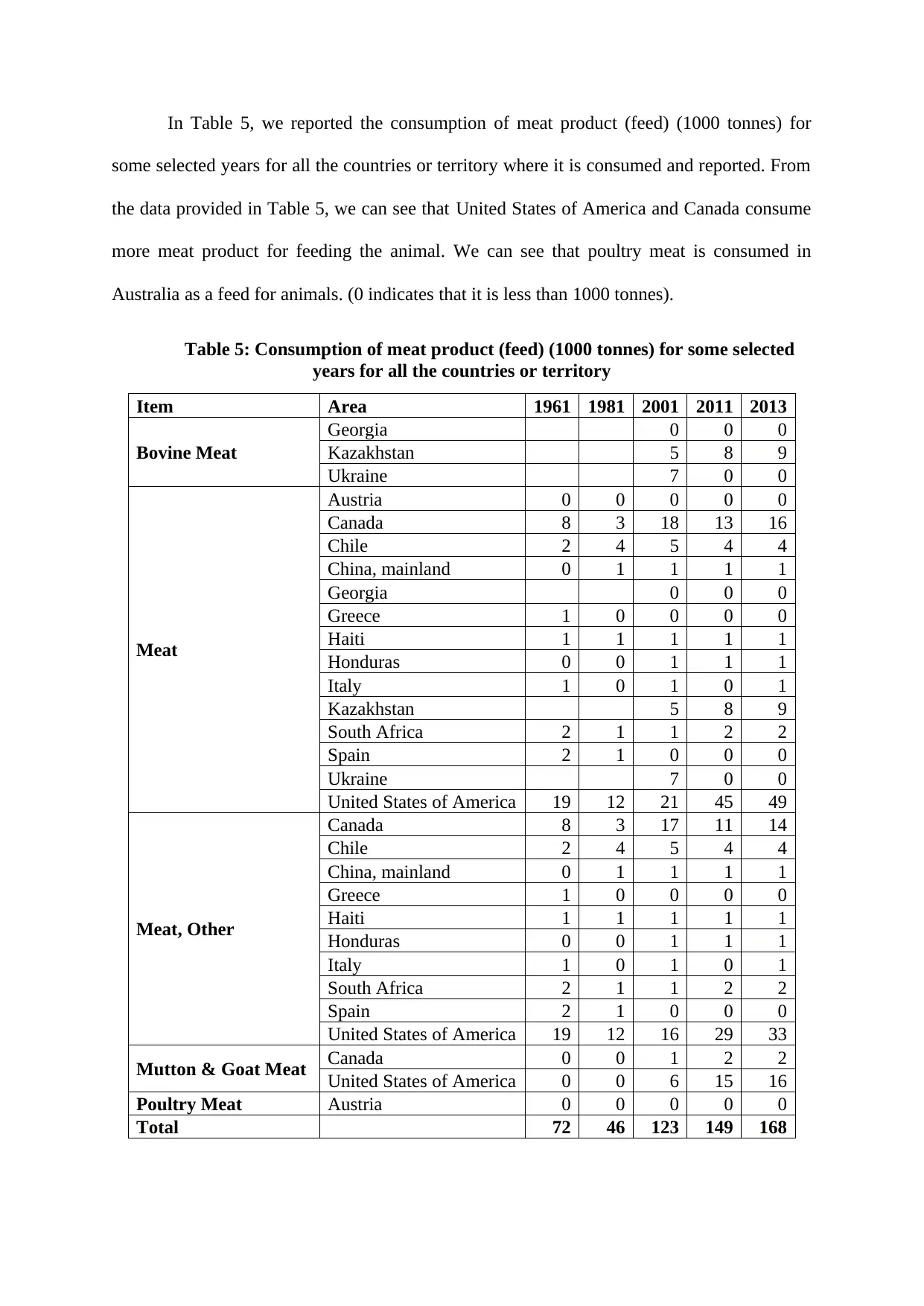
In Table 5, we reported the consumption of meat product (feed) (1000 tonnes) for
some selected years for all the countries or territory where it is consumed and reported. From
the data provided in Table 5, we can see that United States of America and Canada consume
more meat product for feeding the animal. We can see that poultry meat is consumed in
Australia as a feed for animals. (0 indicates that it is less than 1000 tonnes).
Table 5: Consumption of meat product (feed) (1000 tonnes) for some selected
years for all the countries or territory
Item Area 1961 1981 2001 2011 2013
Bovine Meat
Georgia 0 0 0
Kazakhstan 5 8 9
Ukraine 7 0 0
Meat
Austria 0 0 0 0 0
Canada 8 3 18 13 16
Chile 2 4 5 4 4
China, mainland 0 1 1 1 1
Georgia 0 0 0
Greece 1 0 0 0 0
Haiti 1 1 1 1 1
Honduras 0 0 1 1 1
Italy 1 0 1 0 1
Kazakhstan 5 8 9
South Africa 2 1 1 2 2
Spain 2 1 0 0 0
Ukraine 7 0 0
United States of America 19 12 21 45 49
Meat, Other
Canada 8 3 17 11 14
Chile 2 4 5 4 4
China, mainland 0 1 1 1 1
Greece 1 0 0 0 0
Haiti 1 1 1 1 1
Honduras 0 0 1 1 1
Italy 1 0 1 0 1
South Africa 2 1 1 2 2
Spain 2 1 0 0 0
United States of America 19 12 16 29 33
Mutton & Goat Meat Canada 0 0 1 2 2
United States of America 0 0 6 15 16
Poultry Meat Austria 0 0 0 0 0
Total 72 46 123 149 168
some selected years for all the countries or territory where it is consumed and reported. From
the data provided in Table 5, we can see that United States of America and Canada consume
more meat product for feeding the animal. We can see that poultry meat is consumed in
Australia as a feed for animals. (0 indicates that it is less than 1000 tonnes).
Table 5: Consumption of meat product (feed) (1000 tonnes) for some selected
years for all the countries or territory
Item Area 1961 1981 2001 2011 2013
Bovine Meat
Georgia 0 0 0
Kazakhstan 5 8 9
Ukraine 7 0 0
Meat
Austria 0 0 0 0 0
Canada 8 3 18 13 16
Chile 2 4 5 4 4
China, mainland 0 1 1 1 1
Georgia 0 0 0
Greece 1 0 0 0 0
Haiti 1 1 1 1 1
Honduras 0 0 1 1 1
Italy 1 0 1 0 1
Kazakhstan 5 8 9
South Africa 2 1 1 2 2
Spain 2 1 0 0 0
Ukraine 7 0 0
United States of America 19 12 21 45 49
Meat, Other
Canada 8 3 17 11 14
Chile 2 4 5 4 4
China, mainland 0 1 1 1 1
Greece 1 0 0 0 0
Haiti 1 1 1 1 1
Honduras 0 0 1 1 1
Italy 1 0 1 0 1
South Africa 2 1 1 2 2
Spain 2 1 0 0 0
United States of America 19 12 16 29 33
Mutton & Goat Meat Canada 0 0 1 2 2
United States of America 0 0 6 15 16
Poultry Meat Austria 0 0 0 0 0
Total 72 46 123 149 168
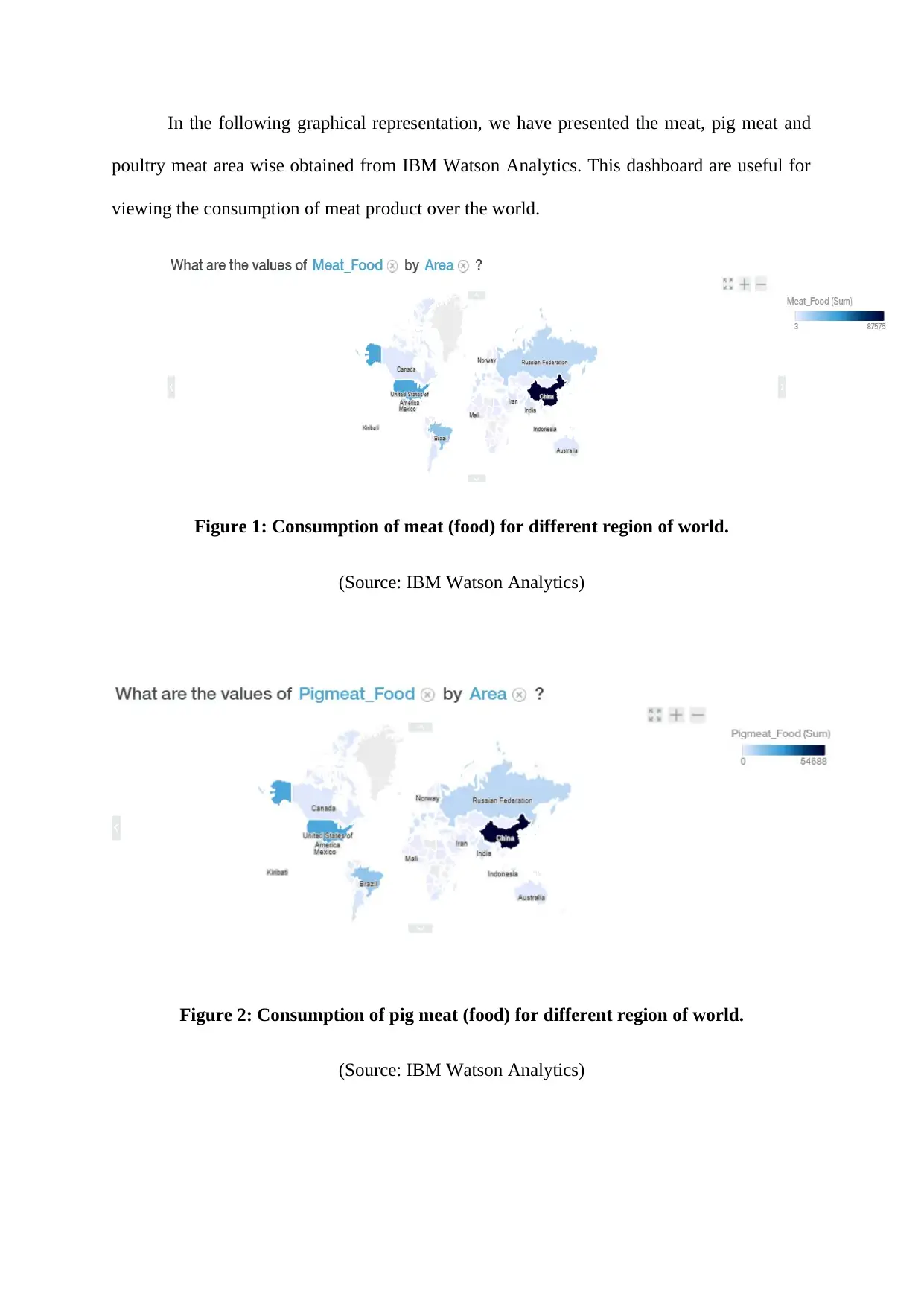
In the following graphical representation, we have presented the meat, pig meat and
poultry meat area wise obtained from IBM Watson Analytics. This dashboard are useful for
viewing the consumption of meat product over the world.
Figure 1: Consumption of meat (food) for different region of world.
(Source: IBM Watson Analytics)
Figure 2: Consumption of pig meat (food) for different region of world.
(Source: IBM Watson Analytics)
poultry meat area wise obtained from IBM Watson Analytics. This dashboard are useful for
viewing the consumption of meat product over the world.
Figure 1: Consumption of meat (food) for different region of world.
(Source: IBM Watson Analytics)
Figure 2: Consumption of pig meat (food) for different region of world.
(Source: IBM Watson Analytics)
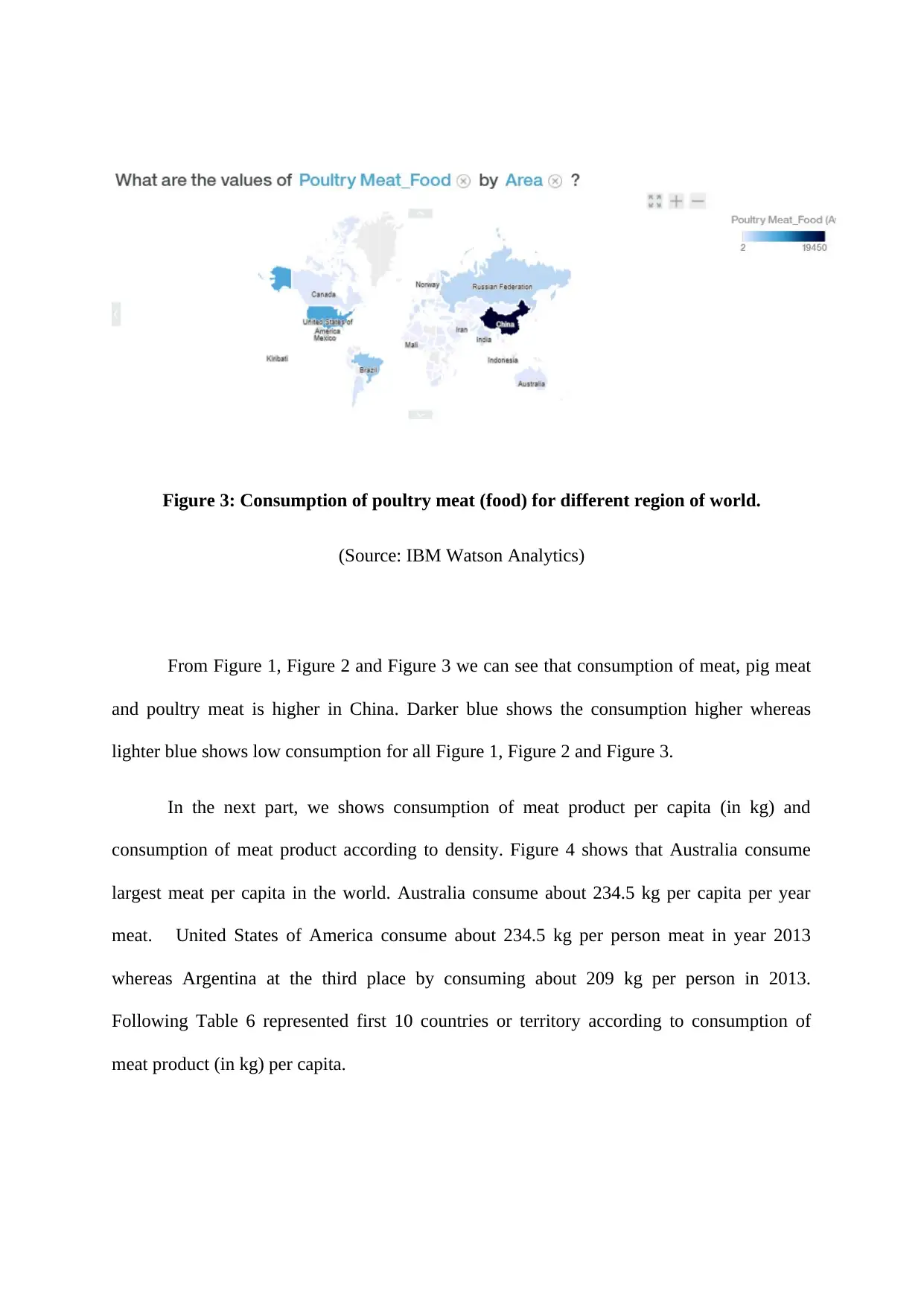
Figure 3: Consumption of poultry meat (food) for different region of world.
(Source: IBM Watson Analytics)
From Figure 1, Figure 2 and Figure 3 we can see that consumption of meat, pig meat
and poultry meat is higher in China. Darker blue shows the consumption higher whereas
lighter blue shows low consumption for all Figure 1, Figure 2 and Figure 3.
In the next part, we shows consumption of meat product per capita (in kg) and
consumption of meat product according to density. Figure 4 shows that Australia consume
largest meat per capita in the world. Australia consume about 234.5 kg per capita per year
meat. United States of America consume about 234.5 kg per person meat in year 2013
whereas Argentina at the third place by consuming about 209 kg per person in 2013.
Following Table 6 represented first 10 countries or territory according to consumption of
meat product (in kg) per capita.
(Source: IBM Watson Analytics)
From Figure 1, Figure 2 and Figure 3 we can see that consumption of meat, pig meat
and poultry meat is higher in China. Darker blue shows the consumption higher whereas
lighter blue shows low consumption for all Figure 1, Figure 2 and Figure 3.
In the next part, we shows consumption of meat product per capita (in kg) and
consumption of meat product according to density. Figure 4 shows that Australia consume
largest meat per capita in the world. Australia consume about 234.5 kg per capita per year
meat. United States of America consume about 234.5 kg per person meat in year 2013
whereas Argentina at the third place by consuming about 209 kg per person in 2013.
Following Table 6 represented first 10 countries or territory according to consumption of
meat product (in kg) per capita.
Paraphrase This Document
Need a fresh take? Get an instant paraphrase of this document with our AI Paraphraser
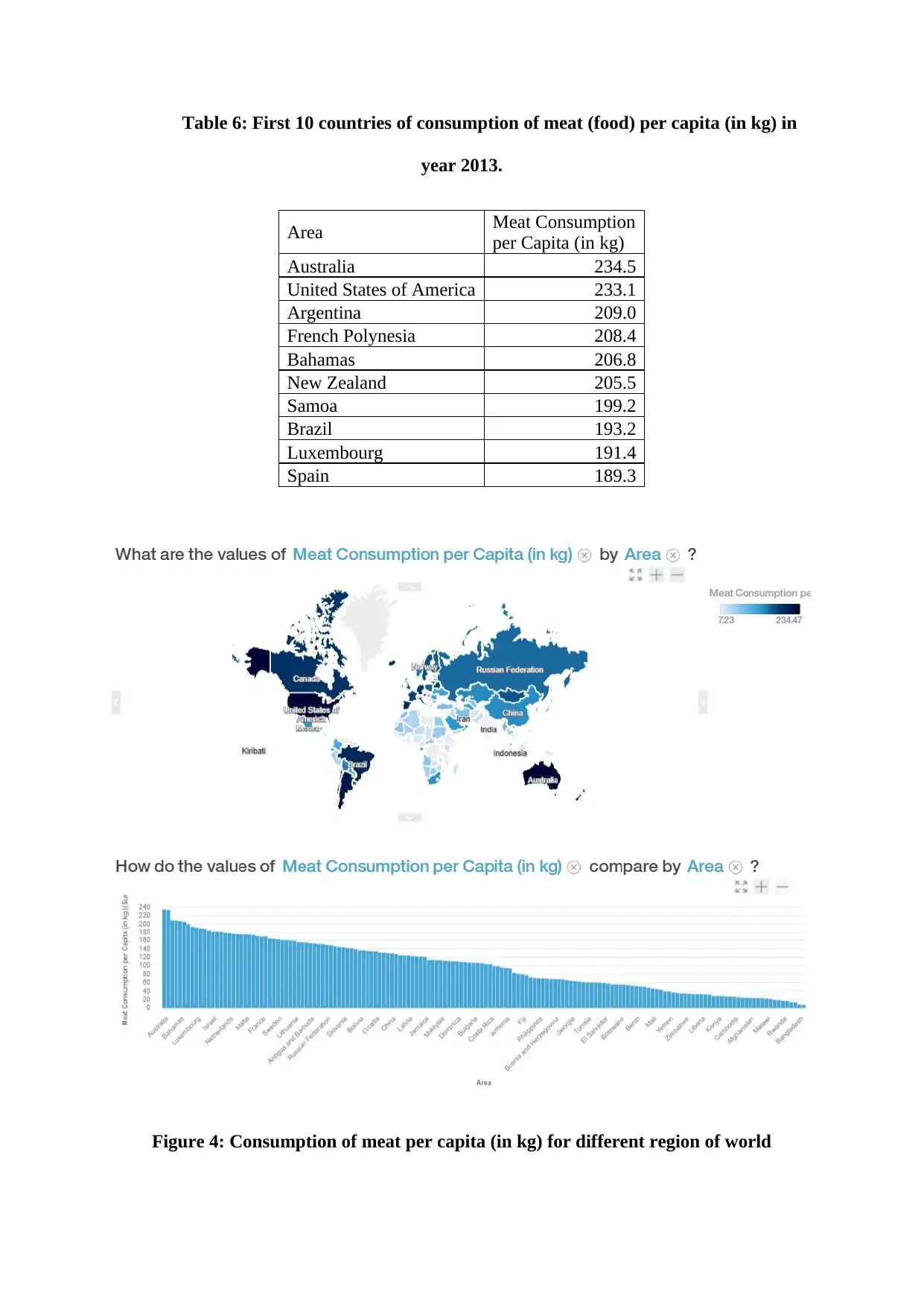
Table 6: First 10 countries of consumption of meat (food) per capita (in kg) in
year 2013.
Area Meat Consumption
per Capita (in kg)
Australia 234.5
United States of America 233.1
Argentina 209.0
French Polynesia 208.4
Bahamas 206.8
New Zealand 205.5
Samoa 199.2
Brazil 193.2
Luxembourg 191.4
Spain 189.3
Figure 4: Consumption of meat per capita (in kg) for different region of world
year 2013.
Area Meat Consumption
per Capita (in kg)
Australia 234.5
United States of America 233.1
Argentina 209.0
French Polynesia 208.4
Bahamas 206.8
New Zealand 205.5
Samoa 199.2
Brazil 193.2
Luxembourg 191.4
Spain 189.3
Figure 4: Consumption of meat per capita (in kg) for different region of world
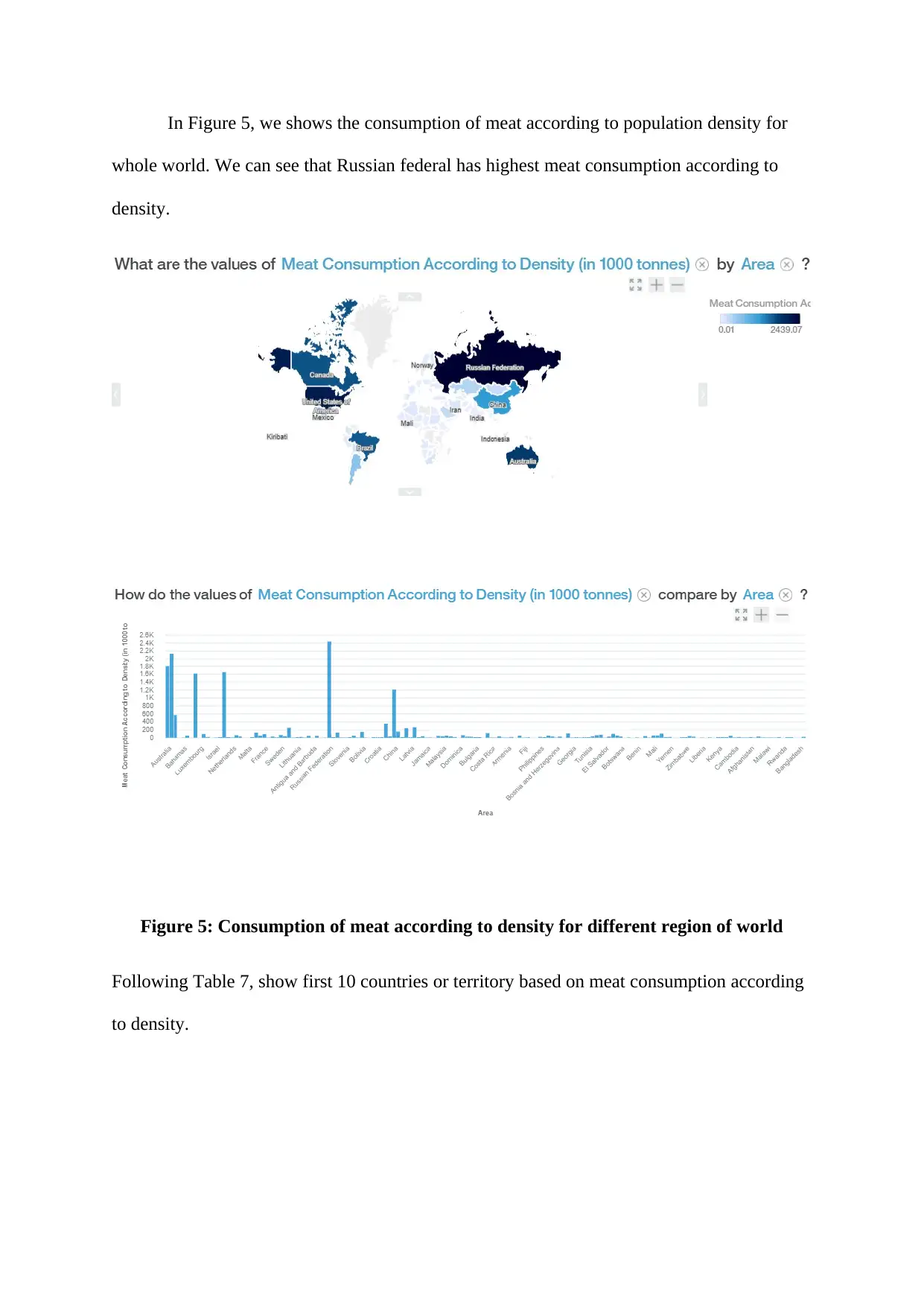
In Figure 5, we shows the consumption of meat according to population density for
whole world. We can see that Russian federal has highest meat consumption according to
density.
Figure 5: Consumption of meat according to density for different region of world
Following Table 7, show first 10 countries or territory based on meat consumption according
to density.
whole world. We can see that Russian federal has highest meat consumption according to
density.
Figure 5: Consumption of meat according to density for different region of world
Following Table 7, show first 10 countries or territory based on meat consumption according
to density.
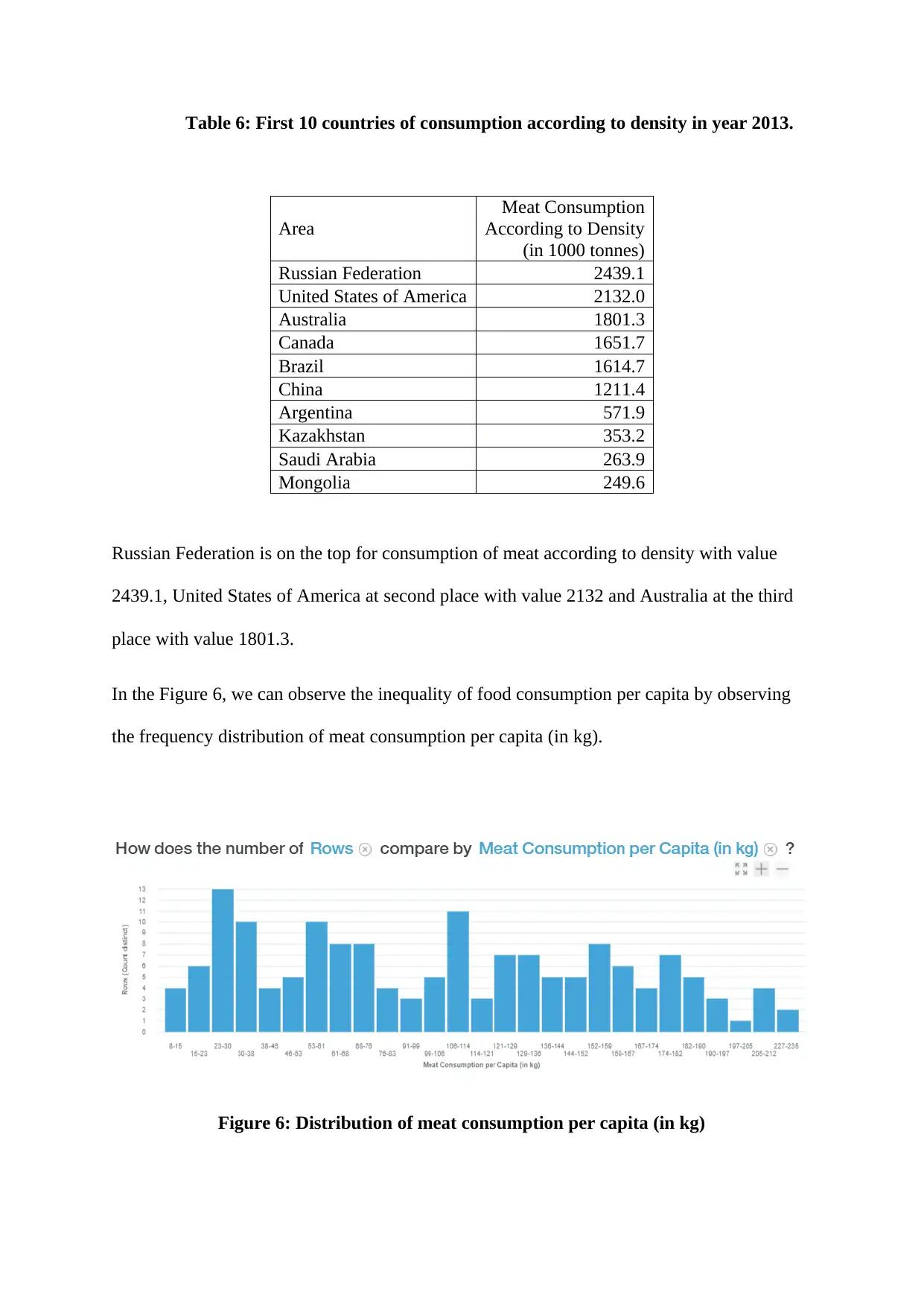
Table 6: First 10 countries of consumption according to density in year 2013.
Russian Federation is on the top for consumption of meat according to density with value
2439.1, United States of America at second place with value 2132 and Australia at the third
place with value 1801.3.
In the Figure 6, we can observe the inequality of food consumption per capita by observing
the frequency distribution of meat consumption per capita (in kg).
Figure 6: Distribution of meat consumption per capita (in kg)
Area
Meat Consumption
According to Density
(in 1000 tonnes)
Russian Federation 2439.1
United States of America 2132.0
Australia 1801.3
Canada 1651.7
Brazil 1614.7
China 1211.4
Argentina 571.9
Kazakhstan 353.2
Saudi Arabia 263.9
Mongolia 249.6
Russian Federation is on the top for consumption of meat according to density with value
2439.1, United States of America at second place with value 2132 and Australia at the third
place with value 1801.3.
In the Figure 6, we can observe the inequality of food consumption per capita by observing
the frequency distribution of meat consumption per capita (in kg).
Figure 6: Distribution of meat consumption per capita (in kg)
Area
Meat Consumption
According to Density
(in 1000 tonnes)
Russian Federation 2439.1
United States of America 2132.0
Australia 1801.3
Canada 1651.7
Brazil 1614.7
China 1211.4
Argentina 571.9
Kazakhstan 353.2
Saudi Arabia 263.9
Mongolia 249.6
Secure Best Marks with AI Grader
Need help grading? Try our AI Grader for instant feedback on your assignments.

We can see that the distribution of consumption of meat per capita (in Kg) is right skewed
suggest that there is inequality in the meat consumption per capita.
Time Series Analysis:
We analyzed the consumption of meat (food) per capita (in Kg) by time series
analysis for the whole world. We used recent 13 years data for the analysis given in the
following Table 7.
Table 7: Consumption of meat (food) per capita (in Kg) for whole world starting
from year 2001 to year 2013.
Year
Consumption of meat (food)
per capita (in Kg)
200
1 72.46255
200
2 73.82114
200
3 74.73732
200
4 74.92095
200
5 75.67426
200
6 77.31705
200
7 79.29835
200
8 80.53394
200
9 80.77335
201
0 81.93073
201
1 82.22724
201
2 83.4884
201
3 84.17584
suggest that there is inequality in the meat consumption per capita.
Time Series Analysis:
We analyzed the consumption of meat (food) per capita (in Kg) by time series
analysis for the whole world. We used recent 13 years data for the analysis given in the
following Table 7.
Table 7: Consumption of meat (food) per capita (in Kg) for whole world starting
from year 2001 to year 2013.
Year
Consumption of meat (food)
per capita (in Kg)
200
1 72.46255
200
2 73.82114
200
3 74.73732
200
4 74.92095
200
5 75.67426
200
6 77.31705
200
7 79.29835
200
8 80.53394
200
9 80.77335
201
0 81.93073
201
1 82.22724
201
2 83.4884
201
3 84.17584
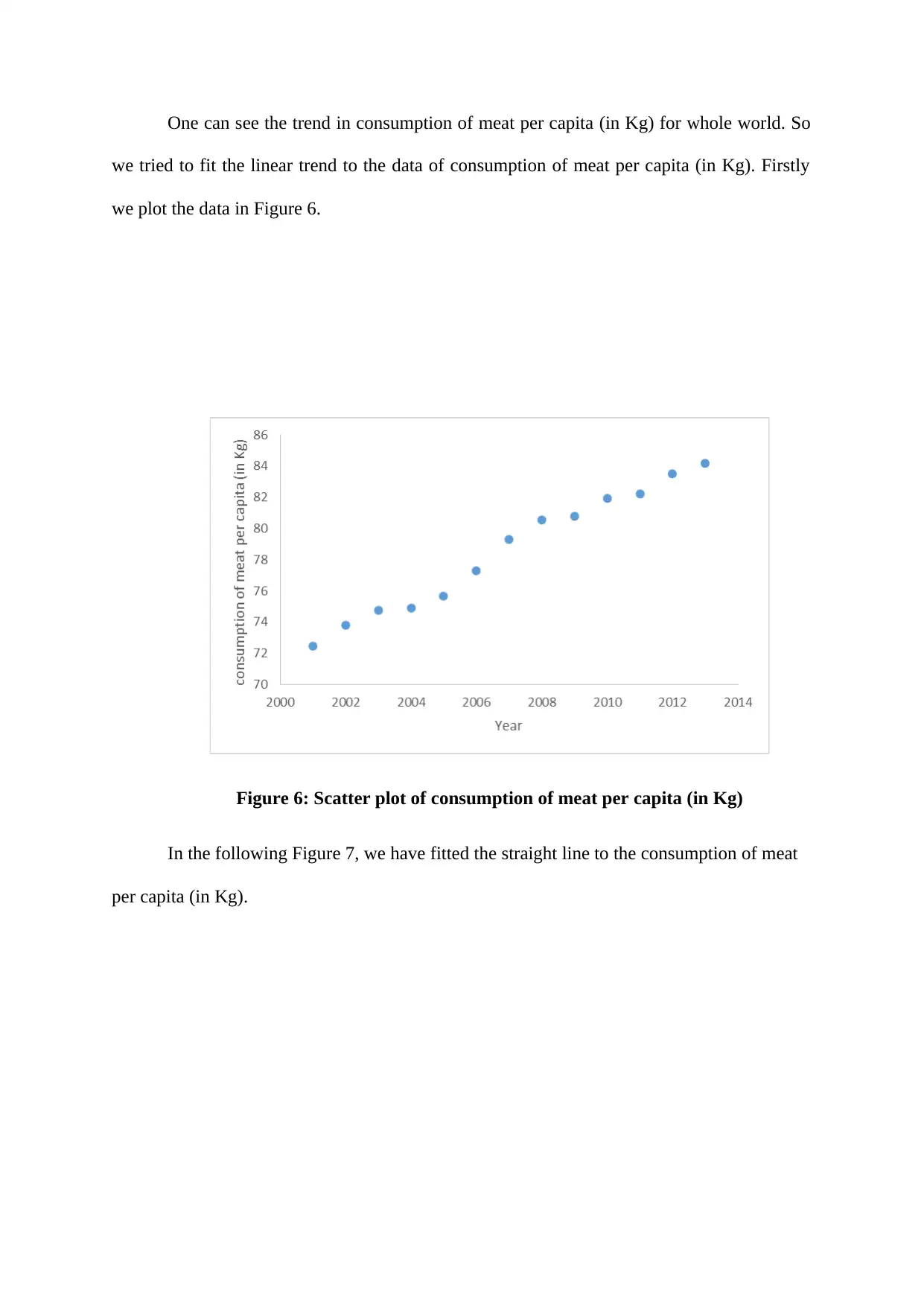
One can see the trend in consumption of meat per capita (in Kg) for whole world. So
we tried to fit the linear trend to the data of consumption of meat per capita (in Kg). Firstly
we plot the data in Figure 6.
Figure 6: Scatter plot of consumption of meat per capita (in Kg)
In the following Figure 7, we have fitted the straight line to the consumption of meat
per capita (in Kg).
we tried to fit the linear trend to the data of consumption of meat per capita (in Kg). Firstly
we plot the data in Figure 6.
Figure 6: Scatter plot of consumption of meat per capita (in Kg)
In the following Figure 7, we have fitted the straight line to the consumption of meat
per capita (in Kg).
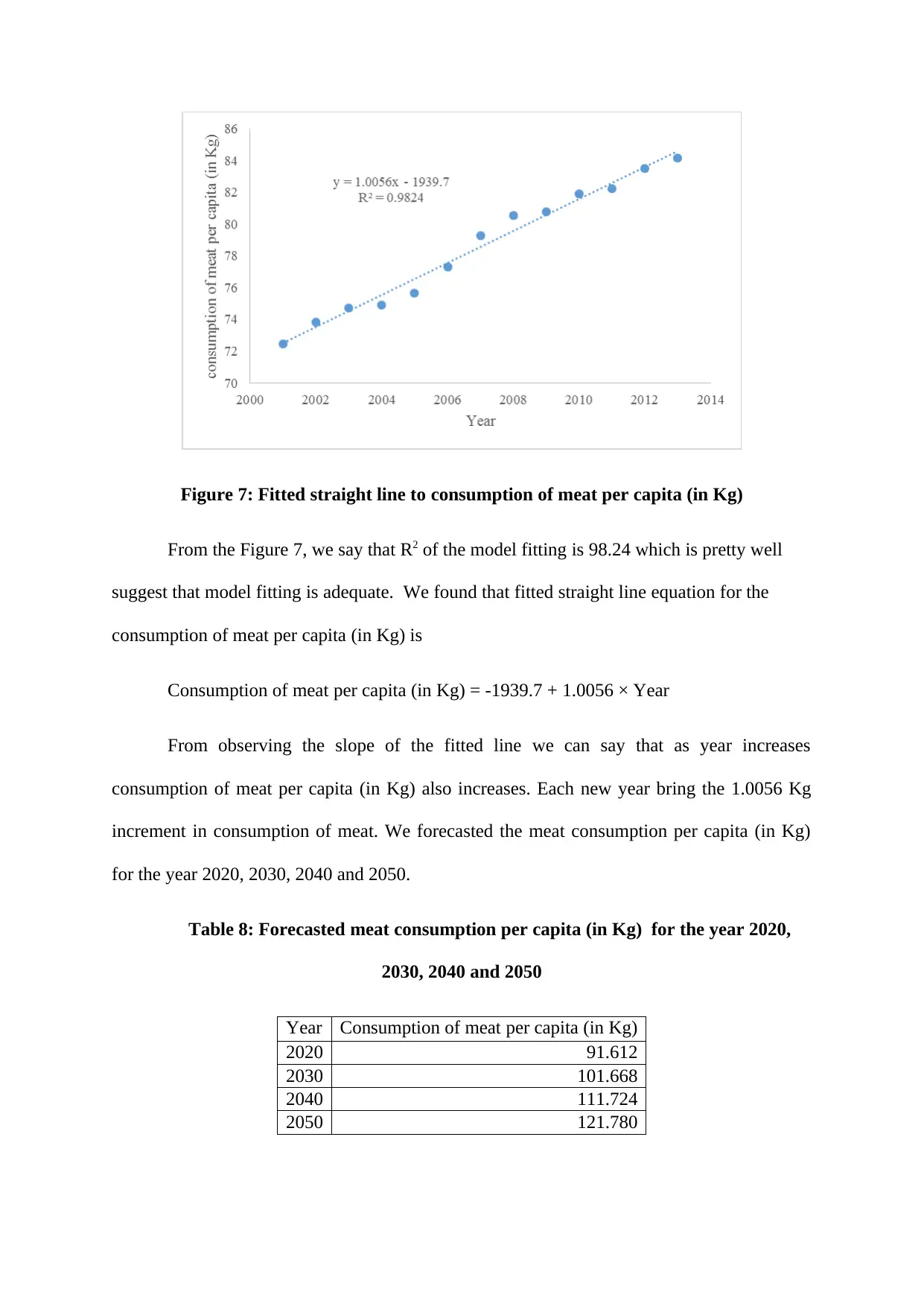
Figure 7: Fitted straight line to consumption of meat per capita (in Kg)
From the Figure 7, we say that R2 of the model fitting is 98.24 which is pretty well
suggest that model fitting is adequate. We found that fitted straight line equation for the
consumption of meat per capita (in Kg) is
Consumption of meat per capita (in Kg) = -1939.7 + 1.0056 × Year
From observing the slope of the fitted line we can say that as year increases
consumption of meat per capita (in Kg) also increases. Each new year bring the 1.0056 Kg
increment in consumption of meat. We forecasted the meat consumption per capita (in Kg)
for the year 2020, 2030, 2040 and 2050.
Table 8: Forecasted meat consumption per capita (in Kg) for the year 2020,
2030, 2040 and 2050
Year Consumption of meat per capita (in Kg)
2020 91.612
2030 101.668
2040 111.724
2050 121.780
From the Figure 7, we say that R2 of the model fitting is 98.24 which is pretty well
suggest that model fitting is adequate. We found that fitted straight line equation for the
consumption of meat per capita (in Kg) is
Consumption of meat per capita (in Kg) = -1939.7 + 1.0056 × Year
From observing the slope of the fitted line we can say that as year increases
consumption of meat per capita (in Kg) also increases. Each new year bring the 1.0056 Kg
increment in consumption of meat. We forecasted the meat consumption per capita (in Kg)
for the year 2020, 2030, 2040 and 2050.
Table 8: Forecasted meat consumption per capita (in Kg) for the year 2020,
2030, 2040 and 2050
Year Consumption of meat per capita (in Kg)
2020 91.612
2030 101.668
2040 111.724
2050 121.780
Paraphrase This Document
Need a fresh take? Get an instant paraphrase of this document with our AI Paraphraser
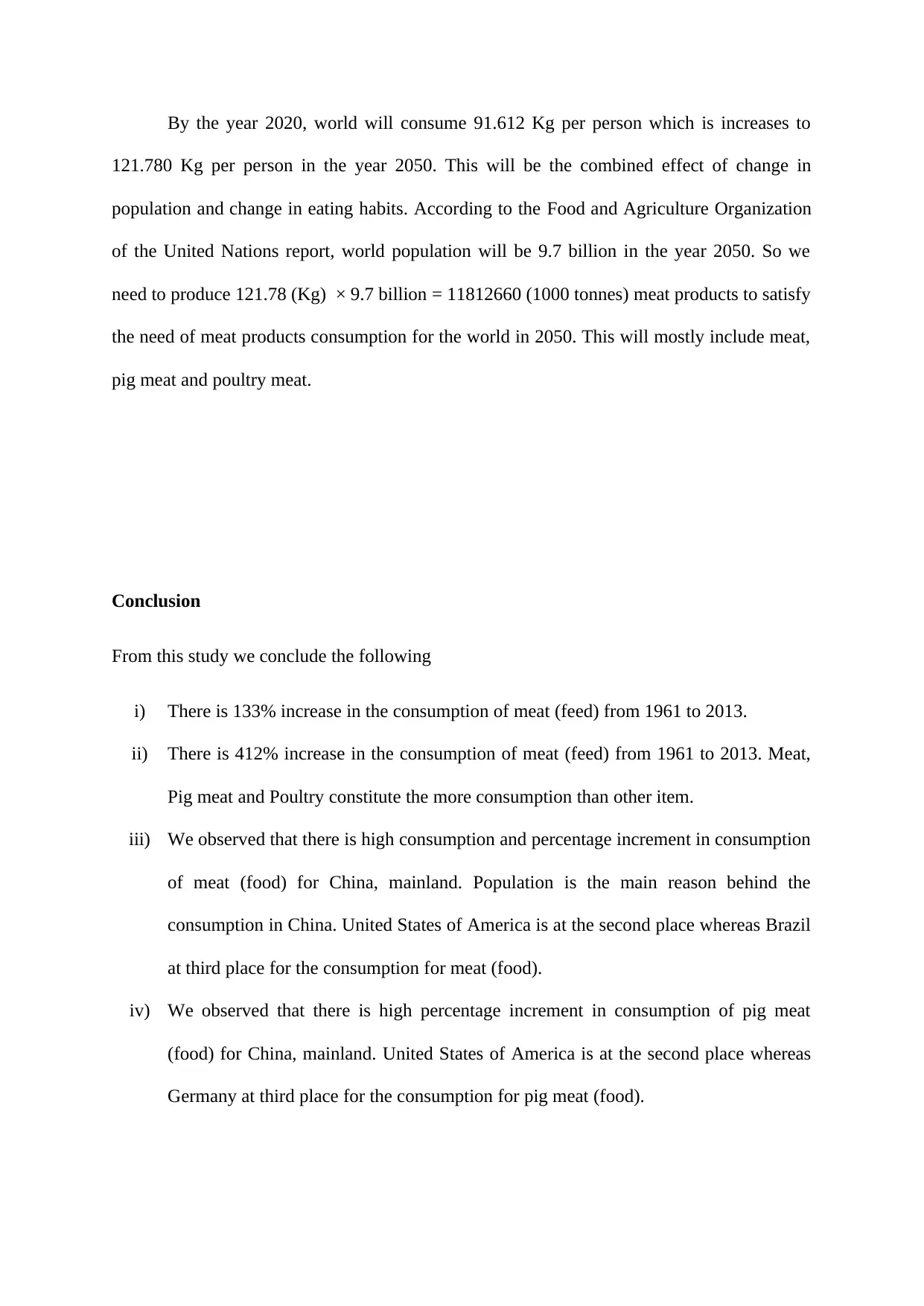
By the year 2020, world will consume 91.612 Kg per person which is increases to
121.780 Kg per person in the year 2050. This will be the combined effect of change in
population and change in eating habits. According to the Food and Agriculture Organization
of the United Nations report, world population will be 9.7 billion in the year 2050. So we
need to produce 121.78 (Kg) × 9.7 billion = 11812660 (1000 tonnes) meat products to satisfy
the need of meat products consumption for the world in 2050. This will mostly include meat,
pig meat and poultry meat.
Conclusion
From this study we conclude the following
i) There is 133% increase in the consumption of meat (feed) from 1961 to 2013.
ii) There is 412% increase in the consumption of meat (feed) from 1961 to 2013. Meat,
Pig meat and Poultry constitute the more consumption than other item.
iii) We observed that there is high consumption and percentage increment in consumption
of meat (food) for China, mainland. Population is the main reason behind the
consumption in China. United States of America is at the second place whereas Brazil
at third place for the consumption for meat (food).
iv) We observed that there is high percentage increment in consumption of pig meat
(food) for China, mainland. United States of America is at the second place whereas
Germany at third place for the consumption for pig meat (food).
121.780 Kg per person in the year 2050. This will be the combined effect of change in
population and change in eating habits. According to the Food and Agriculture Organization
of the United Nations report, world population will be 9.7 billion in the year 2050. So we
need to produce 121.78 (Kg) × 9.7 billion = 11812660 (1000 tonnes) meat products to satisfy
the need of meat products consumption for the world in 2050. This will mostly include meat,
pig meat and poultry meat.
Conclusion
From this study we conclude the following
i) There is 133% increase in the consumption of meat (feed) from 1961 to 2013.
ii) There is 412% increase in the consumption of meat (feed) from 1961 to 2013. Meat,
Pig meat and Poultry constitute the more consumption than other item.
iii) We observed that there is high consumption and percentage increment in consumption
of meat (food) for China, mainland. Population is the main reason behind the
consumption in China. United States of America is at the second place whereas Brazil
at third place for the consumption for meat (food).
iv) We observed that there is high percentage increment in consumption of pig meat
(food) for China, mainland. United States of America is at the second place whereas
Germany at third place for the consumption for pig meat (food).
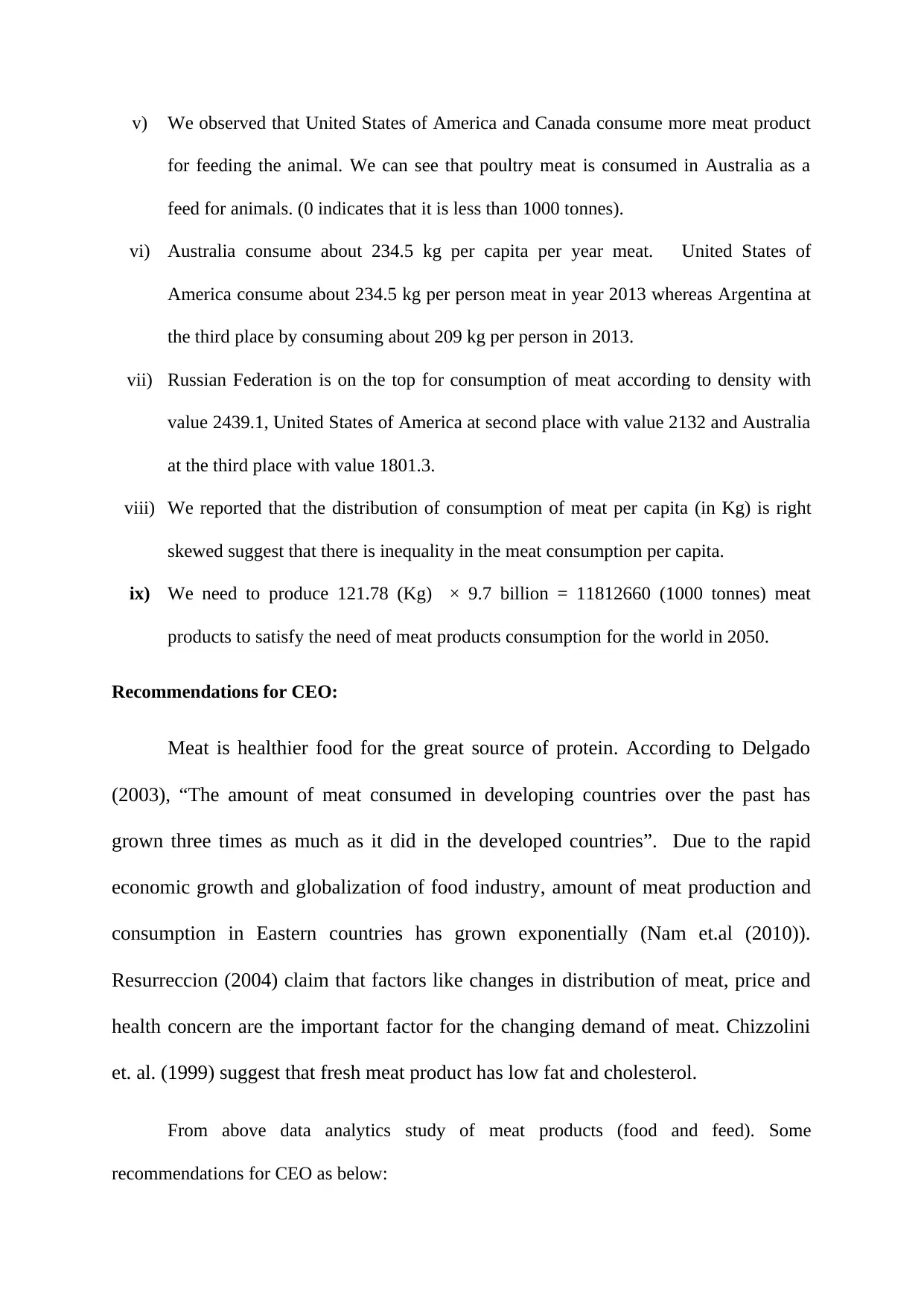
v) We observed that United States of America and Canada consume more meat product
for feeding the animal. We can see that poultry meat is consumed in Australia as a
feed for animals. (0 indicates that it is less than 1000 tonnes).
vi) Australia consume about 234.5 kg per capita per year meat. United States of
America consume about 234.5 kg per person meat in year 2013 whereas Argentina at
the third place by consuming about 209 kg per person in 2013.
vii) Russian Federation is on the top for consumption of meat according to density with
value 2439.1, United States of America at second place with value 2132 and Australia
at the third place with value 1801.3.
viii) We reported that the distribution of consumption of meat per capita (in Kg) is right
skewed suggest that there is inequality in the meat consumption per capita.
ix) We need to produce 121.78 (Kg) × 9.7 billion = 11812660 (1000 tonnes) meat
products to satisfy the need of meat products consumption for the world in 2050.
Recommendations for CEO:
Meat is healthier food for the great source of protein. According to Delgado
(2003), “The amount of meat consumed in developing countries over the past has
grown three times as much as it did in the developed countries”. Due to the rapid
economic growth and globalization of food industry, amount of meat production and
consumption in Eastern countries has grown exponentially (Nam et.al (2010)).
Resurreccion (2004) claim that factors like changes in distribution of meat, price and
health concern are the important factor for the changing demand of meat. Chizzolini
et. al. (1999) suggest that fresh meat product has low fat and cholesterol.
From above data analytics study of meat products (food and feed). Some
recommendations for CEO as below:
for feeding the animal. We can see that poultry meat is consumed in Australia as a
feed for animals. (0 indicates that it is less than 1000 tonnes).
vi) Australia consume about 234.5 kg per capita per year meat. United States of
America consume about 234.5 kg per person meat in year 2013 whereas Argentina at
the third place by consuming about 209 kg per person in 2013.
vii) Russian Federation is on the top for consumption of meat according to density with
value 2439.1, United States of America at second place with value 2132 and Australia
at the third place with value 1801.3.
viii) We reported that the distribution of consumption of meat per capita (in Kg) is right
skewed suggest that there is inequality in the meat consumption per capita.
ix) We need to produce 121.78 (Kg) × 9.7 billion = 11812660 (1000 tonnes) meat
products to satisfy the need of meat products consumption for the world in 2050.
Recommendations for CEO:
Meat is healthier food for the great source of protein. According to Delgado
(2003), “The amount of meat consumed in developing countries over the past has
grown three times as much as it did in the developed countries”. Due to the rapid
economic growth and globalization of food industry, amount of meat production and
consumption in Eastern countries has grown exponentially (Nam et.al (2010)).
Resurreccion (2004) claim that factors like changes in distribution of meat, price and
health concern are the important factor for the changing demand of meat. Chizzolini
et. al. (1999) suggest that fresh meat product has low fat and cholesterol.
From above data analytics study of meat products (food and feed). Some
recommendations for CEO as below:
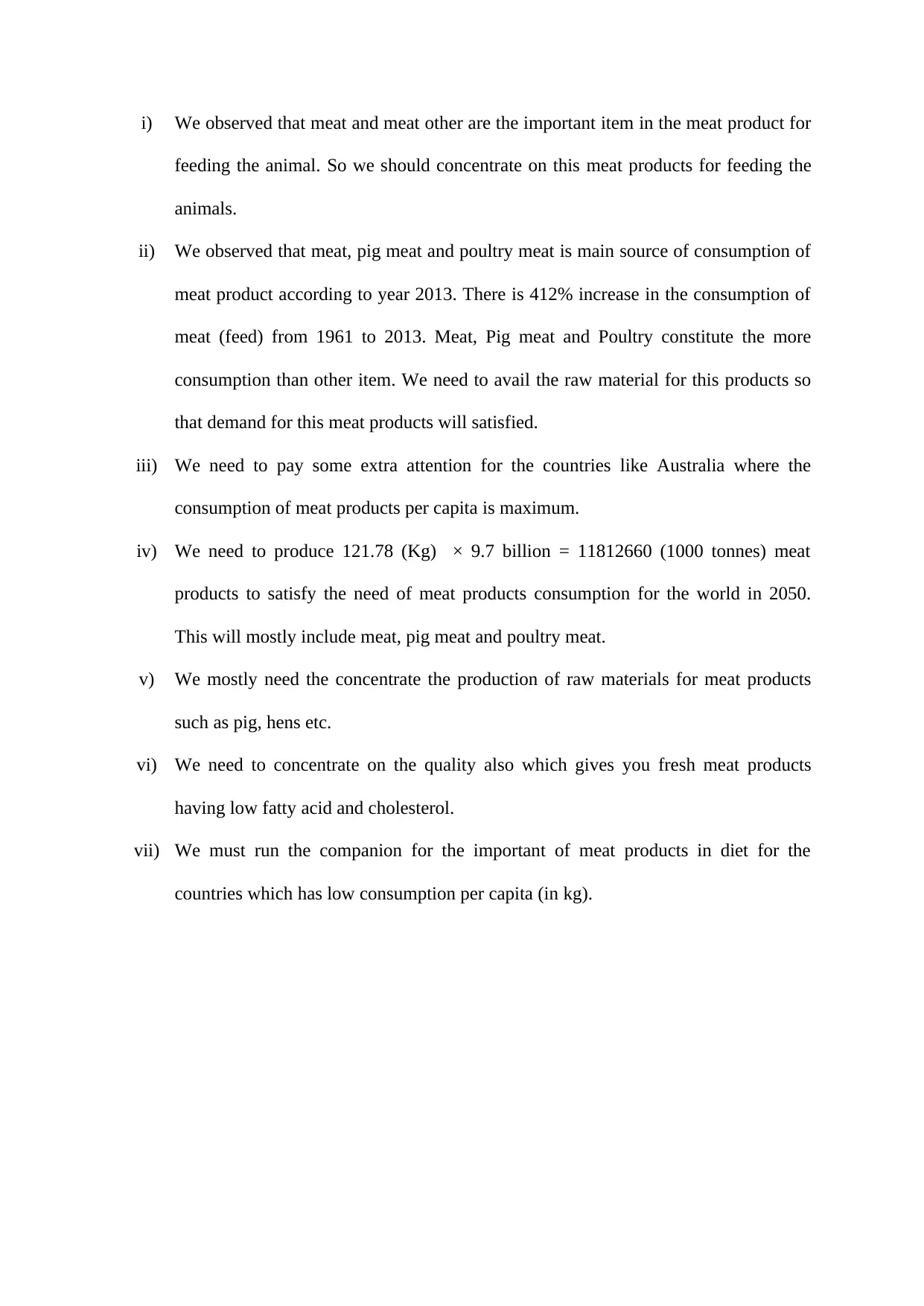
i) We observed that meat and meat other are the important item in the meat product for
feeding the animal. So we should concentrate on this meat products for feeding the
animals.
ii) We observed that meat, pig meat and poultry meat is main source of consumption of
meat product according to year 2013. There is 412% increase in the consumption of
meat (feed) from 1961 to 2013. Meat, Pig meat and Poultry constitute the more
consumption than other item. We need to avail the raw material for this products so
that demand for this meat products will satisfied.
iii) We need to pay some extra attention for the countries like Australia where the
consumption of meat products per capita is maximum.
iv) We need to produce 121.78 (Kg) × 9.7 billion = 11812660 (1000 tonnes) meat
products to satisfy the need of meat products consumption for the world in 2050.
This will mostly include meat, pig meat and poultry meat.
v) We mostly need the concentrate the production of raw materials for meat products
such as pig, hens etc.
vi) We need to concentrate on the quality also which gives you fresh meat products
having low fatty acid and cholesterol.
vii) We must run the companion for the important of meat products in diet for the
countries which has low consumption per capita (in kg).
feeding the animal. So we should concentrate on this meat products for feeding the
animals.
ii) We observed that meat, pig meat and poultry meat is main source of consumption of
meat product according to year 2013. There is 412% increase in the consumption of
meat (feed) from 1961 to 2013. Meat, Pig meat and Poultry constitute the more
consumption than other item. We need to avail the raw material for this products so
that demand for this meat products will satisfied.
iii) We need to pay some extra attention for the countries like Australia where the
consumption of meat products per capita is maximum.
iv) We need to produce 121.78 (Kg) × 9.7 billion = 11812660 (1000 tonnes) meat
products to satisfy the need of meat products consumption for the world in 2050.
This will mostly include meat, pig meat and poultry meat.
v) We mostly need the concentrate the production of raw materials for meat products
such as pig, hens etc.
vi) We need to concentrate on the quality also which gives you fresh meat products
having low fatty acid and cholesterol.
vii) We must run the companion for the important of meat products in diet for the
countries which has low consumption per capita (in kg).
Secure Best Marks with AI Grader
Need help grading? Try our AI Grader for instant feedback on your assignments.
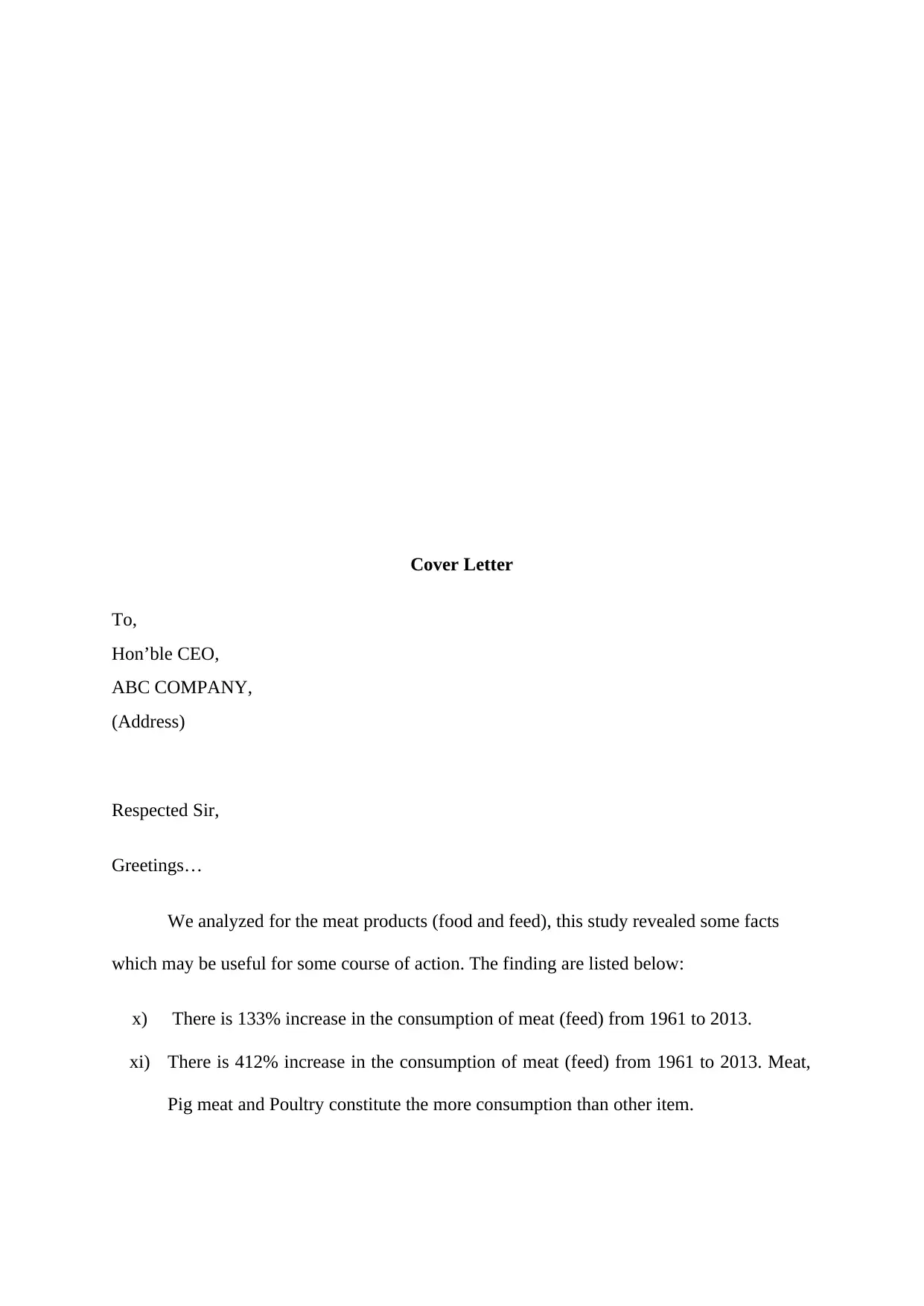
Cover Letter
To,
Hon’ble CEO,
ABC COMPANY,
(Address)
Respected Sir,
Greetings…
We analyzed for the meat products (food and feed), this study revealed some facts
which may be useful for some course of action. The finding are listed below:
x) There is 133% increase in the consumption of meat (feed) from 1961 to 2013.
xi) There is 412% increase in the consumption of meat (feed) from 1961 to 2013. Meat,
Pig meat and Poultry constitute the more consumption than other item.
To,
Hon’ble CEO,
ABC COMPANY,
(Address)
Respected Sir,
Greetings…
We analyzed for the meat products (food and feed), this study revealed some facts
which may be useful for some course of action. The finding are listed below:
x) There is 133% increase in the consumption of meat (feed) from 1961 to 2013.
xi) There is 412% increase in the consumption of meat (feed) from 1961 to 2013. Meat,
Pig meat and Poultry constitute the more consumption than other item.
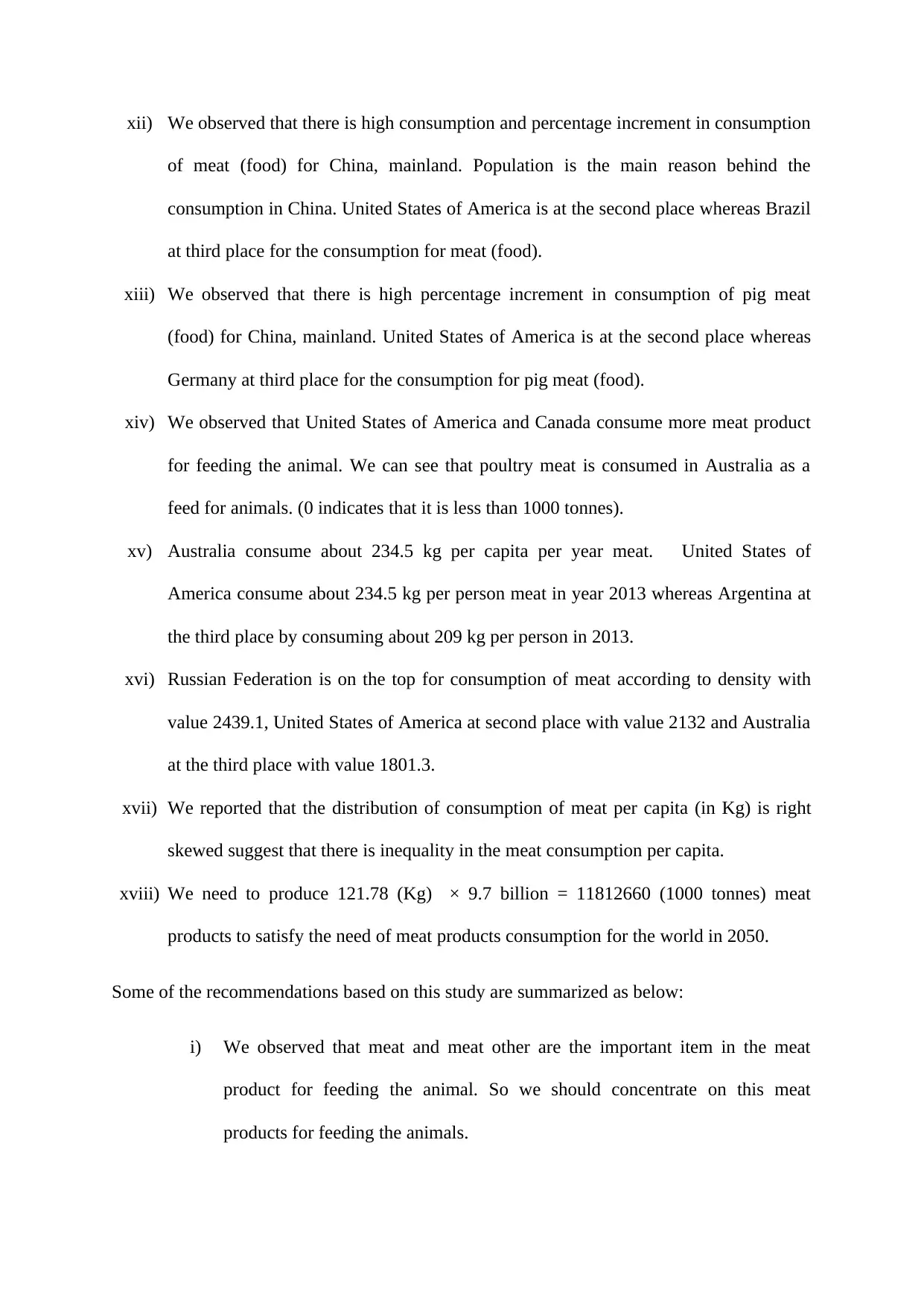
xii) We observed that there is high consumption and percentage increment in consumption
of meat (food) for China, mainland. Population is the main reason behind the
consumption in China. United States of America is at the second place whereas Brazil
at third place for the consumption for meat (food).
xiii) We observed that there is high percentage increment in consumption of pig meat
(food) for China, mainland. United States of America is at the second place whereas
Germany at third place for the consumption for pig meat (food).
xiv) We observed that United States of America and Canada consume more meat product
for feeding the animal. We can see that poultry meat is consumed in Australia as a
feed for animals. (0 indicates that it is less than 1000 tonnes).
xv) Australia consume about 234.5 kg per capita per year meat. United States of
America consume about 234.5 kg per person meat in year 2013 whereas Argentina at
the third place by consuming about 209 kg per person in 2013.
xvi) Russian Federation is on the top for consumption of meat according to density with
value 2439.1, United States of America at second place with value 2132 and Australia
at the third place with value 1801.3.
xvii) We reported that the distribution of consumption of meat per capita (in Kg) is right
skewed suggest that there is inequality in the meat consumption per capita.
xviii) We need to produce 121.78 (Kg) × 9.7 billion = 11812660 (1000 tonnes) meat
products to satisfy the need of meat products consumption for the world in 2050.
Some of the recommendations based on this study are summarized as below:
i) We observed that meat and meat other are the important item in the meat
product for feeding the animal. So we should concentrate on this meat
products for feeding the animals.
of meat (food) for China, mainland. Population is the main reason behind the
consumption in China. United States of America is at the second place whereas Brazil
at third place for the consumption for meat (food).
xiii) We observed that there is high percentage increment in consumption of pig meat
(food) for China, mainland. United States of America is at the second place whereas
Germany at third place for the consumption for pig meat (food).
xiv) We observed that United States of America and Canada consume more meat product
for feeding the animal. We can see that poultry meat is consumed in Australia as a
feed for animals. (0 indicates that it is less than 1000 tonnes).
xv) Australia consume about 234.5 kg per capita per year meat. United States of
America consume about 234.5 kg per person meat in year 2013 whereas Argentina at
the third place by consuming about 209 kg per person in 2013.
xvi) Russian Federation is on the top for consumption of meat according to density with
value 2439.1, United States of America at second place with value 2132 and Australia
at the third place with value 1801.3.
xvii) We reported that the distribution of consumption of meat per capita (in Kg) is right
skewed suggest that there is inequality in the meat consumption per capita.
xviii) We need to produce 121.78 (Kg) × 9.7 billion = 11812660 (1000 tonnes) meat
products to satisfy the need of meat products consumption for the world in 2050.
Some of the recommendations based on this study are summarized as below:
i) We observed that meat and meat other are the important item in the meat
product for feeding the animal. So we should concentrate on this meat
products for feeding the animals.
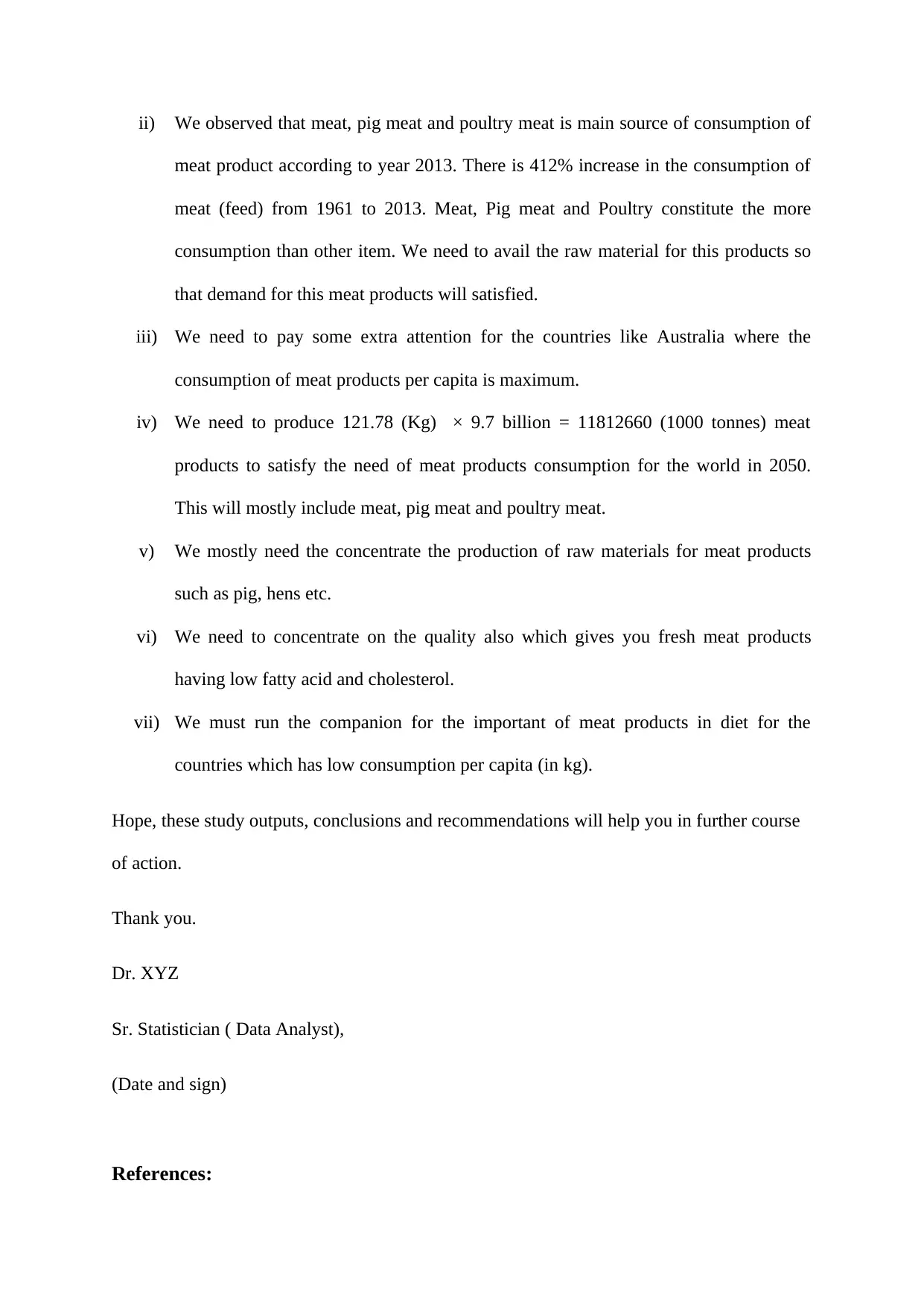
ii) We observed that meat, pig meat and poultry meat is main source of consumption of
meat product according to year 2013. There is 412% increase in the consumption of
meat (feed) from 1961 to 2013. Meat, Pig meat and Poultry constitute the more
consumption than other item. We need to avail the raw material for this products so
that demand for this meat products will satisfied.
iii) We need to pay some extra attention for the countries like Australia where the
consumption of meat products per capita is maximum.
iv) We need to produce 121.78 (Kg) × 9.7 billion = 11812660 (1000 tonnes) meat
products to satisfy the need of meat products consumption for the world in 2050.
This will mostly include meat, pig meat and poultry meat.
v) We mostly need the concentrate the production of raw materials for meat products
such as pig, hens etc.
vi) We need to concentrate on the quality also which gives you fresh meat products
having low fatty acid and cholesterol.
vii) We must run the companion for the important of meat products in diet for the
countries which has low consumption per capita (in kg).
Hope, these study outputs, conclusions and recommendations will help you in further course
of action.
Thank you.
Dr. XYZ
Sr. Statistician ( Data Analyst),
(Date and sign)
References:
meat product according to year 2013. There is 412% increase in the consumption of
meat (feed) from 1961 to 2013. Meat, Pig meat and Poultry constitute the more
consumption than other item. We need to avail the raw material for this products so
that demand for this meat products will satisfied.
iii) We need to pay some extra attention for the countries like Australia where the
consumption of meat products per capita is maximum.
iv) We need to produce 121.78 (Kg) × 9.7 billion = 11812660 (1000 tonnes) meat
products to satisfy the need of meat products consumption for the world in 2050.
This will mostly include meat, pig meat and poultry meat.
v) We mostly need the concentrate the production of raw materials for meat products
such as pig, hens etc.
vi) We need to concentrate on the quality also which gives you fresh meat products
having low fatty acid and cholesterol.
vii) We must run the companion for the important of meat products in diet for the
countries which has low consumption per capita (in kg).
Hope, these study outputs, conclusions and recommendations will help you in further course
of action.
Thank you.
Dr. XYZ
Sr. Statistician ( Data Analyst),
(Date and sign)
References:
Paraphrase This Document
Need a fresh take? Get an instant paraphrase of this document with our AI Paraphraser
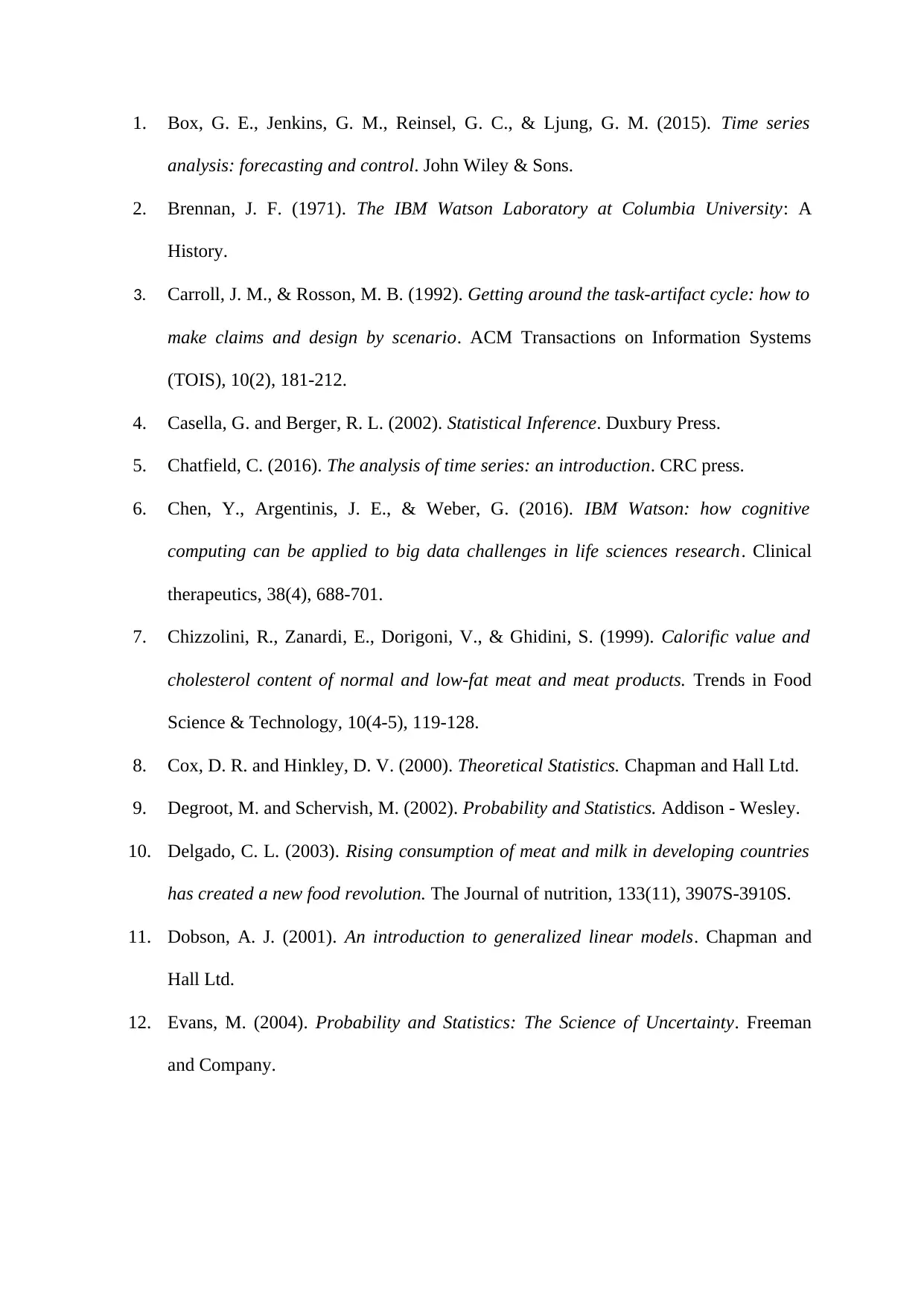
1. Box, G. E., Jenkins, G. M., Reinsel, G. C., & Ljung, G. M. (2015). Time series
analysis: forecasting and control. John Wiley & Sons.
2. Brennan, J. F. (1971). The IBM Watson Laboratory at Columbia University: A
History.
3. Carroll, J. M., & Rosson, M. B. (1992). Getting around the task-artifact cycle: how to
make claims and design by scenario. ACM Transactions on Information Systems
(TOIS), 10(2), 181-212.
4. Casella, G. and Berger, R. L. (2002). Statistical Inference. Duxbury Press.
5. Chatfield, C. (2016). The analysis of time series: an introduction. CRC press.
6. Chen, Y., Argentinis, J. E., & Weber, G. (2016). IBM Watson: how cognitive
computing can be applied to big data challenges in life sciences research. Clinical
therapeutics, 38(4), 688-701.
7. Chizzolini, R., Zanardi, E., Dorigoni, V., & Ghidini, S. (1999). Calorific value and
cholesterol content of normal and low-fat meat and meat products. Trends in Food
Science & Technology, 10(4-5), 119-128.
8. Cox, D. R. and Hinkley, D. V. (2000). Theoretical Statistics. Chapman and Hall Ltd.
9. Degroot, M. and Schervish, M. (2002). Probability and Statistics. Addison - Wesley.
10. Delgado, C. L. (2003). Rising consumption of meat and milk in developing countries
has created a new food revolution. The Journal of nutrition, 133(11), 3907S-3910S.
11. Dobson, A. J. (2001). An introduction to generalized linear models. Chapman and
Hall Ltd.
12. Evans, M. (2004). Probability and Statistics: The Science of Uncertainty. Freeman
and Company.
analysis: forecasting and control. John Wiley & Sons.
2. Brennan, J. F. (1971). The IBM Watson Laboratory at Columbia University: A
History.
3. Carroll, J. M., & Rosson, M. B. (1992). Getting around the task-artifact cycle: how to
make claims and design by scenario. ACM Transactions on Information Systems
(TOIS), 10(2), 181-212.
4. Casella, G. and Berger, R. L. (2002). Statistical Inference. Duxbury Press.
5. Chatfield, C. (2016). The analysis of time series: an introduction. CRC press.
6. Chen, Y., Argentinis, J. E., & Weber, G. (2016). IBM Watson: how cognitive
computing can be applied to big data challenges in life sciences research. Clinical
therapeutics, 38(4), 688-701.
7. Chizzolini, R., Zanardi, E., Dorigoni, V., & Ghidini, S. (1999). Calorific value and
cholesterol content of normal and low-fat meat and meat products. Trends in Food
Science & Technology, 10(4-5), 119-128.
8. Cox, D. R. and Hinkley, D. V. (2000). Theoretical Statistics. Chapman and Hall Ltd.
9. Degroot, M. and Schervish, M. (2002). Probability and Statistics. Addison - Wesley.
10. Delgado, C. L. (2003). Rising consumption of meat and milk in developing countries
has created a new food revolution. The Journal of nutrition, 133(11), 3907S-3910S.
11. Dobson, A. J. (2001). An introduction to generalized linear models. Chapman and
Hall Ltd.
12. Evans, M. (2004). Probability and Statistics: The Science of Uncertainty. Freeman
and Company.
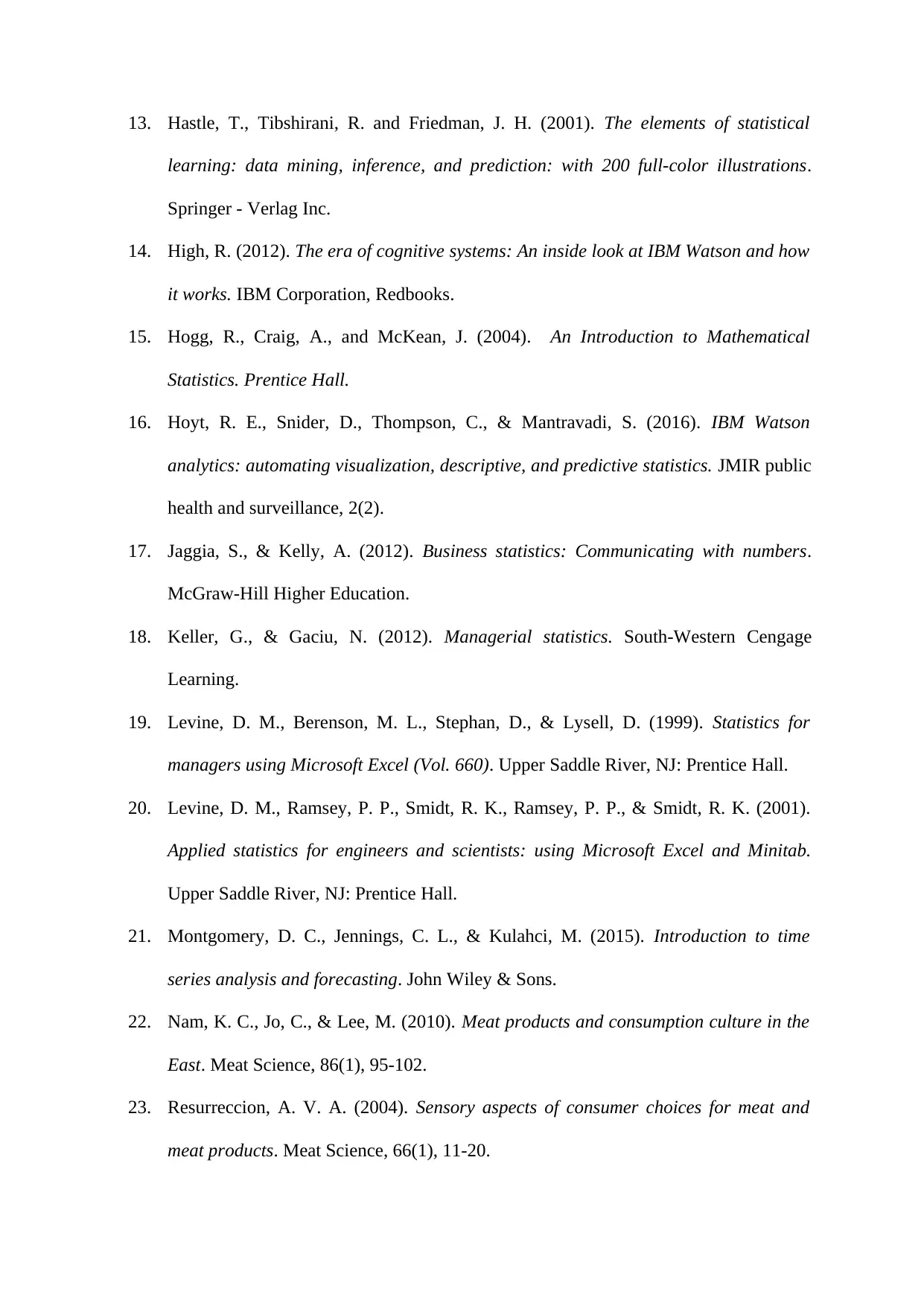
13. Hastle, T., Tibshirani, R. and Friedman, J. H. (2001). The elements of statistical
learning: data mining, inference, and prediction: with 200 full-color illustrations.
Springer - Verlag Inc.
14. High, R. (2012). The era of cognitive systems: An inside look at IBM Watson and how
it works. IBM Corporation, Redbooks.
15. Hogg, R., Craig, A., and McKean, J. (2004). An Introduction to Mathematical
Statistics. Prentice Hall.
16. Hoyt, R. E., Snider, D., Thompson, C., & Mantravadi, S. (2016). IBM Watson
analytics: automating visualization, descriptive, and predictive statistics. JMIR public
health and surveillance, 2(2).
17. Jaggia, S., & Kelly, A. (2012). Business statistics: Communicating with numbers.
McGraw-Hill Higher Education.
18. Keller, G., & Gaciu, N. (2012). Managerial statistics. South-Western Cengage
Learning.
19. Levine, D. M., Berenson, M. L., Stephan, D., & Lysell, D. (1999). Statistics for
managers using Microsoft Excel (Vol. 660). Upper Saddle River, NJ: Prentice Hall.
20. Levine, D. M., Ramsey, P. P., Smidt, R. K., Ramsey, P. P., & Smidt, R. K. (2001).
Applied statistics for engineers and scientists: using Microsoft Excel and Minitab.
Upper Saddle River, NJ: Prentice Hall.
21. Montgomery, D. C., Jennings, C. L., & Kulahci, M. (2015). Introduction to time
series analysis and forecasting. John Wiley & Sons.
22. Nam, K. C., Jo, C., & Lee, M. (2010). Meat products and consumption culture in the
East. Meat Science, 86(1), 95-102.
23. Resurreccion, A. V. A. (2004). Sensory aspects of consumer choices for meat and
meat products. Meat Science, 66(1), 11-20.
learning: data mining, inference, and prediction: with 200 full-color illustrations.
Springer - Verlag Inc.
14. High, R. (2012). The era of cognitive systems: An inside look at IBM Watson and how
it works. IBM Corporation, Redbooks.
15. Hogg, R., Craig, A., and McKean, J. (2004). An Introduction to Mathematical
Statistics. Prentice Hall.
16. Hoyt, R. E., Snider, D., Thompson, C., & Mantravadi, S. (2016). IBM Watson
analytics: automating visualization, descriptive, and predictive statistics. JMIR public
health and surveillance, 2(2).
17. Jaggia, S., & Kelly, A. (2012). Business statistics: Communicating with numbers.
McGraw-Hill Higher Education.
18. Keller, G., & Gaciu, N. (2012). Managerial statistics. South-Western Cengage
Learning.
19. Levine, D. M., Berenson, M. L., Stephan, D., & Lysell, D. (1999). Statistics for
managers using Microsoft Excel (Vol. 660). Upper Saddle River, NJ: Prentice Hall.
20. Levine, D. M., Ramsey, P. P., Smidt, R. K., Ramsey, P. P., & Smidt, R. K. (2001).
Applied statistics for engineers and scientists: using Microsoft Excel and Minitab.
Upper Saddle River, NJ: Prentice Hall.
21. Montgomery, D. C., Jennings, C. L., & Kulahci, M. (2015). Introduction to time
series analysis and forecasting. John Wiley & Sons.
22. Nam, K. C., Jo, C., & Lee, M. (2010). Meat products and consumption culture in the
East. Meat Science, 86(1), 95-102.
23. Resurreccion, A. V. A. (2004). Sensory aspects of consumer choices for meat and
meat products. Meat Science, 66(1), 11-20.

24. Sincich, T., Levine, D. M., & Stephan, D. (1999). Practical statistics by example
using Microsoft Excel. Prentice Hall.
25. Triola, M. F. (2013). Elementary statistics using Excel. Pearson.
using Microsoft Excel. Prentice Hall.
25. Triola, M. F. (2013). Elementary statistics using Excel. Pearson.
1 out of 22
Related Documents
Your All-in-One AI-Powered Toolkit for Academic Success.
+13062052269
info@desklib.com
Available 24*7 on WhatsApp / Email
![[object Object]](/_next/static/media/star-bottom.7253800d.svg)
Unlock your academic potential
© 2024 | Zucol Services PVT LTD | All rights reserved.





